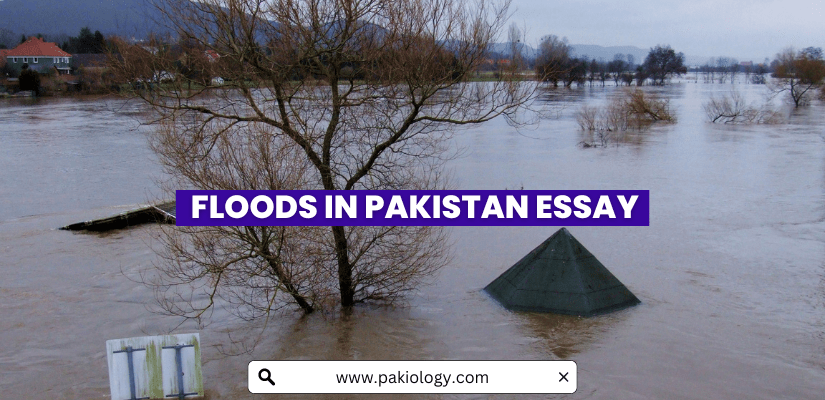

Floods in Pakistan Essay: Causes and Prevention
by Pakiology | Apr 21, 2024 | Essay , English | 0 comments
Get a comprehensive understanding of the devastating effects of floods in Pakistan through this in-depth Floods In Pakistan Essay. Learn about the causes, prevention, and role of government in addressing this issue.
Here are two perfect essays on floods in Pakistan. It is a hot topic right now. It is very possible that your examiner will target this topic for your upcoming exam. So prepare these essays very well.
Page Contents
800 Words Essay on Floods In Pakistan With Quotations
Impacts of floods in pakistan, mitigating the adverse effects of floods in pakistan, 400 words essay on floods in pakistan.
Pakistan experiences devastating floods every year, causing loss of life and property. Despite being a common disaster in the country, the impact of floods remains devastating. In this article, we delve into the causes and impacts of floods in Pakistan and explore ways to mitigate their adverse effects.
What Causes Floods in Pakistan?
Monsoon rainfall:.
Pakistan’s location in the monsoon region makes it susceptible to heavy rainfall during the monsoon season, which can cause widespread flooding. This is because heavy downpours in a short period of time can overwhelm the drainage systems, causing water to overflow into low-lying areas and causing widespread damage. Additionally, the country’s topography, with its mountain ranges, valleys, and plains, also exacerbates the problem by channeling the water into narrow channels and causing flash floods.
Glacial Melt:
The Himalayan glaciers, located in northern Pakistan, are melting at an alarming rate, which contributes to the country’s flood problem. The melting of these glaciers increases the volume of water in rivers and streams, causing them to overflow their banks and result in widespread flooding. The problem is further exacerbated by the rapid rate at which the glaciers are melting, which results in a large amount of water being released into rivers and streams all at once, leading to a sudden increase in the water levels and causing flash floods.
Poor Drainage System:
The inadequate drainage system in Pakistan is a major cause of floods. The poor design of the drainage channels and the rampant illegal construction in the country can result in blockages and obstructions, which can cause water to back up and overflow into surrounding areas, resulting in widespread flooding. Additionally, the illegal construction of buildings and infrastructure in flood-prone areas can also exacerbate the problem by blocking the flow of water and causing water to accumulate in low-lying areas.
Deforestation:
The rapid deforestation in Pakistan is also contributing to the frequency and intensity of floods in the country. Trees play a crucial role in retaining water and reducing runoff, and their loss can lead to increased runoff and flooding. Deforestation also reduces the amount of vegetation that can absorb water, leading to a more rapid runoff of water into rivers and streams and causing them to overflow their banks and result in widespread flooding.
Loss of Life and Property:
Floods in Pakistan have a devastating impact on human lives, often resulting in the loss of lives and widespread damage to property and infrastructure, especially in rural areas where residents have limited access to resources and support. The destruction of homes, businesses, schools, and hospitals can have long-lasting effects on communities, displacing families and causing widespread poverty and homelessness.
Health Crises:
Floods in Pakistan can pose a serious threat to public health, spreading waterborne diseases such as cholera, dysentery, and malaria. With contaminated water sources, the risk of water-borne illnesses increases, putting the lives of millions of people at risk, especially in areas where there are limited healthcare facilities.
Agricultural Disruption:
The agricultural sector, which is the backbone of Pakistan’s economy, is often severely impacted by floods, damaging crops and reducing soil fertility. This can have a significant impact on food security, leading to food shortages and increased prices, affecting the livelihoods of millions of farmers and their families.
Economic Losses:
In addition to the loss of human lives, floods in Pakistan can result in massive economic losses, particularly for small businesses and farmers. The destruction of infrastructure, such as roads, bridges, and transportation systems, can disrupt trade and commerce, causing significant financial losses for businesses.
Improved Drainage System:
To prevent blockages and reduce the risk of floods, the drainage system in Pakistan must be improved. This can include upgrading existing channels, constructing new ones, and ensuring proper maintenance to prevent blockages.
Afforestation:
The government should launch a massive afforestation drive to restore tree cover, which can help to reduce runoff and prevent floods. By planting trees, the government can mitigate the effects of floods and provide a long-term solution to protect communities from the adverse impacts of floods.
Strict Construction Regulations:
To prevent illegal construction and blockages, strict construction regulations must be enforced. This can include implementing fines and penalties for violators and providing support to local authorities to enforce these regulations.
Flood Early Warning System:
To ensure timely evacuation and advance warning, an effective flood early warning system should be in place. This can include installing early warning systems, such as flood gauges and weather monitoring systems, to provide real-time information to communities, allowing them to evacuate and prepare in advance.
In conclusion, floods are a recurring problem in Pakistan, causing widespread damage to life and property. By addressing the root causes and implementing measures to enhance the country’s preparedness and response mechanisms, we can reduce the frequency and intensity of floods in Pakistan and ensure a safer and more sustainable future for all
Floods in Pakistan have been a major natural disaster for the country. They are caused by heavy rainfall during the monsoon season, as well as by melting snow from the Himalayas. These floods can cause widespread destruction, including damage to homes, infrastructure, and crops.
The 2022 floods in Pakistan were particularly severe, affecting more than 33 million people and causing billions of dollars in damage. The floods affected large areas of the country, including the Balochistan, Sindh, Punjab, and Khyber Pakhtunkhwa provinces. The heavy rainfall and overflowing rivers caused widespread destruction, including damage to homes, roads, and crops.
The impact of floods on Pakistan can be devastating. In addition to the physical damage caused by floods, they can also have a significant economic impact. Floods can destroy crops and damage infrastructure, leading to a loss of income for farmers and businesses. They can also disrupt transportation and communication networks, making it difficult for people to access essential goods and services.
The government of Pakistan has taken steps to try to prevent and mitigate the effects of floods. This includes building dams and other infrastructure to control the flow of water, as well as providing support to affected communities. However, much more needs to be done to address the issue of floods in Pakistan.
As I mentioned earlier, the government of Pakistan has taken steps to try to prevent and mitigate the effects of floods. This includes building dams and other infrastructure to control the flow of water, as well as providing support to affected communities.
However, there are also other measures that can be taken to reduce the impact of floods in Pakistan. For example, improving drainage systems and increasing vegetation in flood-prone areas can help to absorb excess water and reduce the risk of flooding. In addition, educating communities about the risks of floods and how to prepare for them can help to reduce the loss of life and property.
It is also important for the government to work with international organizations and other countries to develop more effective strategies for dealing with floods. This could include sharing information and expertise, as well as providing financial and technical assistance. By working together, it may be possible to reduce the impact of floods in Pakistan and protect communities from the devastating effects of this natural disaster.
In conclusion, floods in Pakistan are a major natural disaster that can have devastating effects on the country. They are caused by heavy rainfall and melting snow and can cause significant damage to homes, infrastructure, and crops. The government of Pakistan has taken steps to try to prevent and mitigate the effects of floods, but more needs to be done to address this issue.
Find more Essays on the following Topics
Ask Your Questions
You might like, democracy in pakistan essay with quotations.
Explore the evolution, challenges, and progress of democracy in Pakistan in this in-depth essay. Gain insights into...
Problems of Karachi Essay | 200 & 500 Words
Explore the multifaceted challenges faced by Karachi in this comprehensive essay. From overpopulation to traffic...
A True Muslim Essay With Quotations 2023
A true Muslim essay is about the qualities of a true Muslim and how they embody the teachings of Islam in their daily...
An Essay on My Mother: A Tribute to Mothers
Mothers are the backbone of a family and a crucial influence in the lives of their children. From an early age,...
Submit a Comment Cancel reply
Your email address will not be published. Required fields are marked *
Save my name, email, and website in this browser for the next time I comment.
Submit Comment
- class-9-notes
- Friendship quotes
- Scholarships
- Science News
- Study Abroad
- Study in Australia
- SZABMU MDCAT
- UHS Past MCQs
- Universities
Pakistan’s floods are a disaster – but they didn’t have to be
Professor of Disasters and Health, UCL
Disclosure statement
Ilan Kelman receives funding from research councils in the UK and Norway, as well as from the Wellcome Trust and internal UCL funding. He is also Professor II at the University of Agder in Norway and co-directs the non-profit organisation Risk RED (Risk Reduction Education for Disasters).
University College London provides funding as a founding partner of The Conversation UK.
View all partners
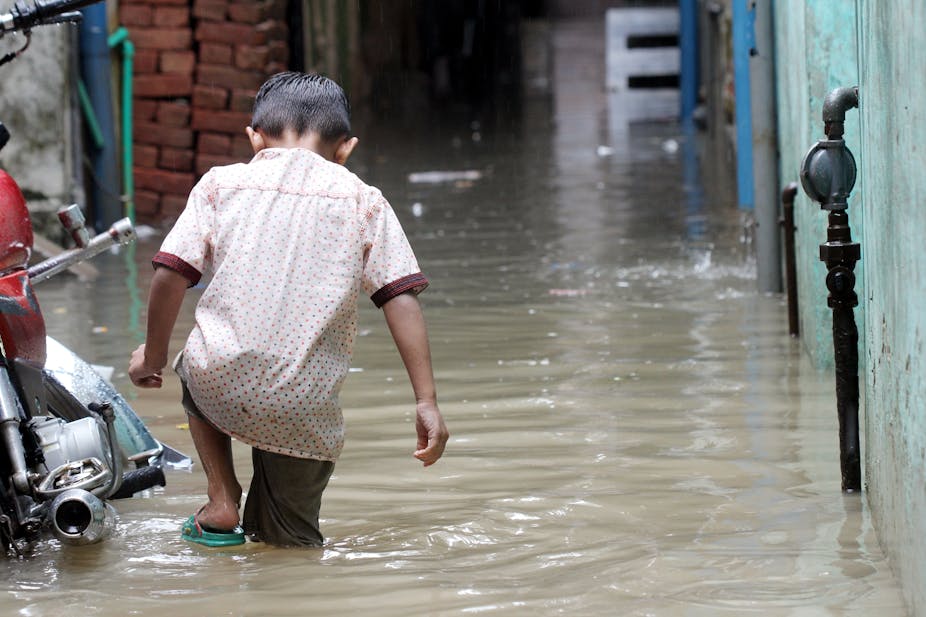
The devastating flooding affecting Pakistan has killed over 1,300 people, damaged over 1.7 million homes, and is disrupting food production. Over 33 million people have been affected so far.
The destruction caused by these so-called “natural disasters” is often accepted as largely unavoidable and unpredictable. Climate change is also blamed for the alleged increased frequency of disasters.
However, decades of research explain that disasters are instead caused by sources of vulnerability rather than by the climate or other environmental influences. Sources of vulnerability stem from a lack of power and resources to prepare for hazards. This includes poorly designed infrastructure along with social marginalisation and inequity, which restrict access to education and other key services.
A disaster is where the ability of people to cope with a hazard or its impacts by using their own resources is exceeded. Where resources are scarce or inadequate, a hazard often adversely affects people.
Consequently, framing a flood as a “natural disaster” deflects from the reality that vulnerability must exist before a crisis can emerge. The failure of governments to suitably prepare people for these hazards is a root cause of disaster. No matter the severity of the flooding event, a disaster can be avoided .
Vulnerability to floods remains high
Pakistan has been subject to regular flooding throughout history. This year’s flood is the country’s sixth since 1950 to kill over 1,000 people . These disasters have encouraged numerous attempts at flood risk management .
However, vulnerability towards flooding remains high . Many of the existing management measures may even have unintentionally worsened the effects of flooding. Poorly implemented urban development throughout Pakistan has further contributed by exacerbating surface runoff.
Structural measures have dominated flood risk management in Pakistan. This is despite research suggesting that a reliance on them can worsen the impact of flooding.
People tend to view engineered structures as being safe and protective . Presuming the infallibility of these structures, they adjust their livelihoods and lifestyles accordingly. When a large flood occurs and these structures are breached, the impacts of flooding are amplified.
In 2005, the Shadi Kaur dam in the southern province of Balochistan broke during heavy rains, claiming the lives of over 135 people . The current floods have damaged eight dams in the same region.

Pakistan’s focus on large scale infrastructure and response measures has led to a neglect for nonstructural risk reduction measures . Many people therefore have few options to address their vulnerability.
A 2016 study concluded that people in Pakistan’s Khyber Pukhthunkhwa province had little awareness of flood risks and how to prepare. Education and employment rates in the region remain low . A literacy rate of 57% greatly restricts access to information enabling risk reduction.
Many people continue to live on floodplains for agriculture and as a result remain highly vulnerable. Despite investment in warning systems , these serve little purpose if people are unaware of how to act or do not have the resources to do so.
Gender inequity remains prevalent across rural Pakistan . This makes women particularly vulnerable to flooding because they are more likely to face the issues related to employment and education highlighted above.
The extensive damage during this year’s flooding is therefore unsurprising. Khyber Pukthunkhwa has been badly inundated , forcing almost 70,000 people into temporary camps.
Addressing Pakistan’s vulnerability
Pakistan’s current flood management strategies do not adequately address vulnerability. While flood management is gradually shifting away from centralised and post-disaster measures , progress has been slow.
Pakistan needs to adopt a proactive approach to swiftly address the underlying causes of vulnerability. People need better access to information about flood risks as well as the resources to help them prepare. In the future, disasters will persist unless profound changes are made. This must include steps to ensure effective governance, to encourage safe land use and to guarantee full access to education.
Human activities are changing the climate with clear consequences on the weather . An extended period of high rainfall contributed to severe floods in Pakistan this year. However, the consequent catastrophe has been created by human actions .
The resources and techniques exist to avoid flood disasters in Pakistan. However, these resources have not been distributed effectively. While climate change influences the frequency of flooding, it does not create flood disasters. Where vulnerable people are placed at risk, a catastrophe follows.
- Natural disasters
- Framing effect
- Disaster preparedness
- Poor governance
- Flood management
- Pakistan floods

Events and Communications Coordinator

Assistant Editor - 1 year cadetship

Executive Dean, Faculty of Health

Lecturer/Senior Lecturer, Earth System Science (School of Science)

Sydney Horizon Educators (Identified)
- International edition
- Australia edition
- Europe edition

‘Monster monsoon’: why the floods in Pakistan are so devastating
The climate crisis is the prime suspect, but the vulnerability of poor citizens and other factors are important too
The climate crisis is the prime suspect for the devastating scale of flooding in Pakistan , which has killed more than 1,000 people and affected 30 million. But the catastrophe, still unfolding, is most likely the result of a lethal combination of factors including the vulnerability of poor citizens, steep mountainous slopes in some regions, the unexpected destruction of embankments and dams, and some natural climate variation.
The horrific scale of the floods are not in doubt. “We are witnessing the worst flooding in the history of the country,” said Dr Fahad Saeed, a climate scientist with the Climate Analytics group, who is based in Islamabad.
The obvious cause is the record-breaking rainfall. “Pakistan has never seen an unbroken cycle of monsoon [rains] like this,” said Sherry Rehman , Pakistan’s climate change minister. “Eight weeks of non-stop torrents have left huge swathes of the country underwater. This is a deluge from all sides.” She said the “monster monsoon was wreaking non-stop havoc throughout the country”.
From the beginning of the month, the rainfall was nine times higher than average in Sindh province and five times higher across the whole of Pakistan. Basic physics is the reason rainfall is becoming intense around the world – warmer air holds more moisture.
Scientists are already trying to determine the extent to which global heating is to blame for the rainfall and floods. But analysis of the previous worst flood in 2010 suggests it will be significant. That “superflood” was made more likely by global heating, which drove fiercer rains.
Warmer oceans and heating in the Arctic were implicated in the 2010 superflood, one study found, as these factors affected the jet stream, a high-level wind that circles the planet. The greater meandering of the jet stream led to both the prolonged rain in Pakistan and an extreme heatwave in Russia that year.
And according to a 2021 study global heating is making the south Asian monsoon more intense and more erratic , with each 1C rise in global temperature leading to 5% more rain.
Pakistan has suffered regular flooding since 2010, as well as heatwaves and wildfires. “Climate change is really affecting us,” said Saeed. “It has become a norm now that every year we kind of face extreme events.”

The current floods would have been expected less than once a century, according to Dr Liz Stephens, an associate professor of climate risks and resilience at the University of Reading, UK, who is part of a global flood forecasting system. “We can see it is very extreme flooding and, in many places, it will be worse than 2010, when the floods killed 1,700 people.”
Two critical factors in the high death toll are flash flooding and the destruction of river embankments, Stephens said. Some of the intense rains have hit places where the water rapidly runs off steep slopes. “Flash flooding is very difficult to provide good warning for and to get people out of harm’s way quickly,” she said.
River embankments have also been destroyed. “You can’t predict when they are going to fail, and people living in an area where they think they’re protected might not expect that they need to evacuate.”
Stephens said: “We’re talking about potentially unprecedented volumes of water – it would have been inconceivable that some parts of these catchments would have been affected. People don’t prepare for risks that they are not familiar with.”
Deforestation could also have increased the speed of rain runoff in places, Stephens said, while Saeed said dams had been destroyed on the Kabul River that runs into the Indus.
A natural climate cycle driven by temperature and wind variations in the Pacific may also have added to the Pakistan floods, said meteorologist Scott Duncan. The El Niño–Southern Oscillation (Enso) appears to be in its La Niña phase, as it was in 2010. “La Niña is behaving very strongly in some metrics and is a significant factor for enhancing monsoonal rains in my opinion,” he said. However, how global heating affects Enso is not currently well understood.
The population of Pakistan is especially at risk from extreme weather driven by the climate emergency, ranked eighth most at risk in the world by the Global Climate Risk Index. “Pakistan is very vulnerable to extremes and the whiplash from unprecedented heat from March to May this year followed by a strong monsoon makes the impact on society and the economy even more severe,” said Duncan. The extreme heatwave suffered earlier in 2022 was made 30 times more likely by global heating and another heatwave in 2015 was also exacerbated by global heating .
“What you see today is just a trailer of what’s in store for us with poverty, hunger, malnutrition and disease if we don’t pay heed to climate change,” said development and climate expert Ali Tauqeer Sheikh.
The only silver lining in the current flooding situation is that it may not get even more catastrophic. “Thankfully, no further significant rainfall is expected over the coming days as the end of the monsoon season nears,” said Nicholas Lee at MetDesk .
However, it is clear that the climate crisis is supercharging the toll of extreme weather across the globe, even with just 1.1C of global heating to date. Pakistan is the latest country where lives and livelihoods are being lost. “It’s a real planet SOS here,” said Rehman .
- Extreme weather
- Climate crisis
- South and central Asia
Most viewed

- High contrast
- Press Centre
Search UNICEF
Devastating floods in pakistan, one year after historic floods devastated pakistan, unicef remains on the ground, working with partners to help children and families..

Last updated: 25 August 2023
One year after unprecedented floods ravaged Pakistan, millions of children still need humanitarian assistance and access to essential services.
Many of the hardest-hit districts were among the most vulnerable in the country, where children already suffered from high malnutrition, poor access to water and sanitation, and low school enrollment. The loss of vital infrastructure – including thousands of schools and public health facilities – deepened pre-existing inequities, leaving children even more at risk of hunger and disease.
UNICEF has been on the ground with partners since day one of the emergency response, and remains committed to supporting families still affected by the devastation.
We need your urgent support to help save lives:
What happened?
The 2022 floods submerged one third of the country, affecting 33 million people, half of whom were children. The floods damaged most of the water systems in affected areas, forcing more than 5.4 million people to rely solely on contaminated water from ponds and wells.
Unsafe water and poor sanitation are key underlying causes of malnutrition. Associated diseases, such as diarrhoea, prevent children from getting the vital nutrients they need. When children become malnourished, their weakened immune systems make them even more susceptible to waterborne diseases, perpetuating a vicious cycle of malnutrition and infection.

How UNICEF is supporting children in Pakistan
Since August 2022, UNICEF and partners have reached 3.6 million people with primary health-care services; enabled access to safe water for 1.7 million people in areas where water networks were damaged or destroyed; reached over 545,000 children and caregivers with mental health and psychosocial support; and supported education for over 258,000 children. UNICEF has also screened more than 2 million children for severe acute malnutrition and admitted over 170,000 children for life-saving treatment.
Still, the needs continue to outstrip the resources required to respond.

Your contribution can help UNICEF reach more children and families with life-saving supplies.

How does UNICEF respond in emergencies?
When an emergency such as an earthquake or typhoon strikes, it’s children who suffer first and most. UNICEF is on the ground before, during, and after emergencies, working to reach children and families with lifesaving aid and long-term assistance.
How critical supplies are supporting children in Pakistan
Take a look at UNICEF's critical role in providing shelter, medicines and education to children and families affected by 2022’s catastrophic floods.
One year on from catastrophic floods, millions of children in Pakistan still need urgent support
Receding waters reveal scars of climate change in Pakistan
The impact of last year’s historic floods will be felt for years to come by children and their families
More than 10 million people, including children, living in Pakistan’s flood-affected areas still lack access to safe drinking water
Confronting Climate Anxiety: One Year After the Floods in Pakistan
This photo essay was originally published by Al Jazeera in October 2023.
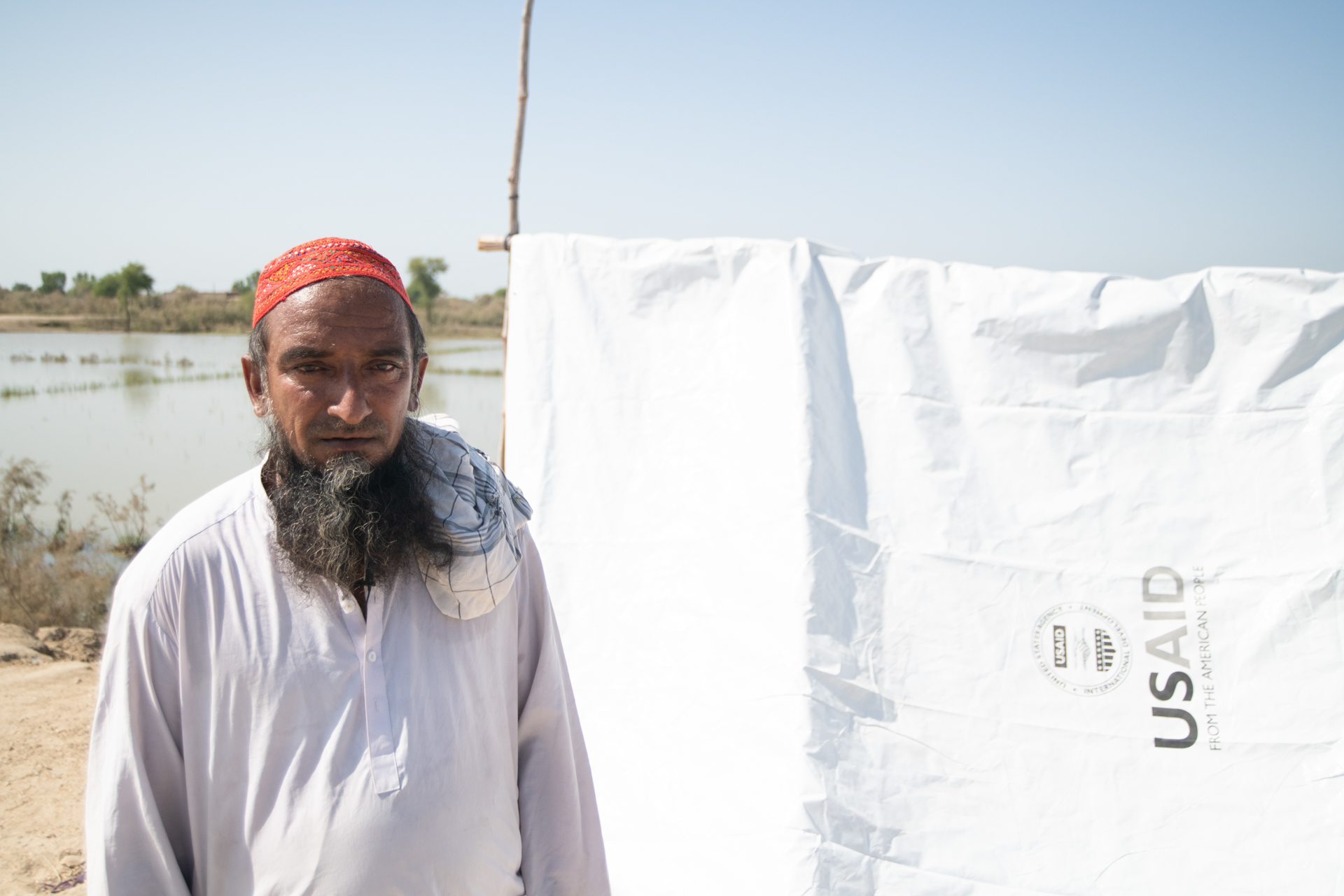
"Even if the floods continue to devastate our village year after year, I have no choice but to stay here. I can't even afford the bus fare to the city, and we have nowhere else to go," Muhammad shared. His village in district Shikarpur has been repeatedly hit by floods in 2010, 2011, 2012 and 2022. Photo: IOM 2022/Usman Ghani
Pakistan, 16 November 2023 – One year ago, Pakistan experienced unprecedented floods. Over 33 million people were directly affected, with a staggering 20.6 million requiring urgent humanitarian assistance. The consequences were dire – 7.9 million people were displaced, and over 2 million houses were destroyed.
Although the water has receded, one year later, the scars of the natural hazard remain fresh. Over 1.5 million people are still displaced. The most basic necessities, such as food and shelter, continue to be out of reach for a large portion of the flood-affected population, more than 40 per cent of whom rely on humanitarian aid for survival.
While the immediate concerns of food, shelter, and water have been largely documented, climate anxiety among flood-affected communities across Pakistan has failed to make headlines.
Although climate anxiety is a newly coined term, it reflects a distress that has long been felt by these communities.
Amidst the increasing threat of climate change, floods in Pakistan have grown more frequent, resulting in some communities facing an unending cycle of displacement and despair. For these communities, the fatigue caused by climate-change-induced disasters has begun to take its toll. They are not only exhausted but also more anxious than ever about the potential threat of cascading disasters.
Men, women and children alike in these flood-affected areas are living in fear of an uncertain future. They grapple with the harsh reality that they lack the necessary preparations to face another flood, and they have no clear plans for shelter should their already fragile homes become uninhabitable.
These communities are in a constant struggle to meet their basic survival needs, and the anxiety about recurrent climate-related disasters adds an additional layer of uncertainty to their lives.
Despite contributing very little to the current global climate breakdown, Pakistan remains one of the countries most vulnerable to the effects of climate change. As the nation grapples with the devastating impact of climate change, climate anxiety will likely continue to rise, especially among the most vulnerable populations.
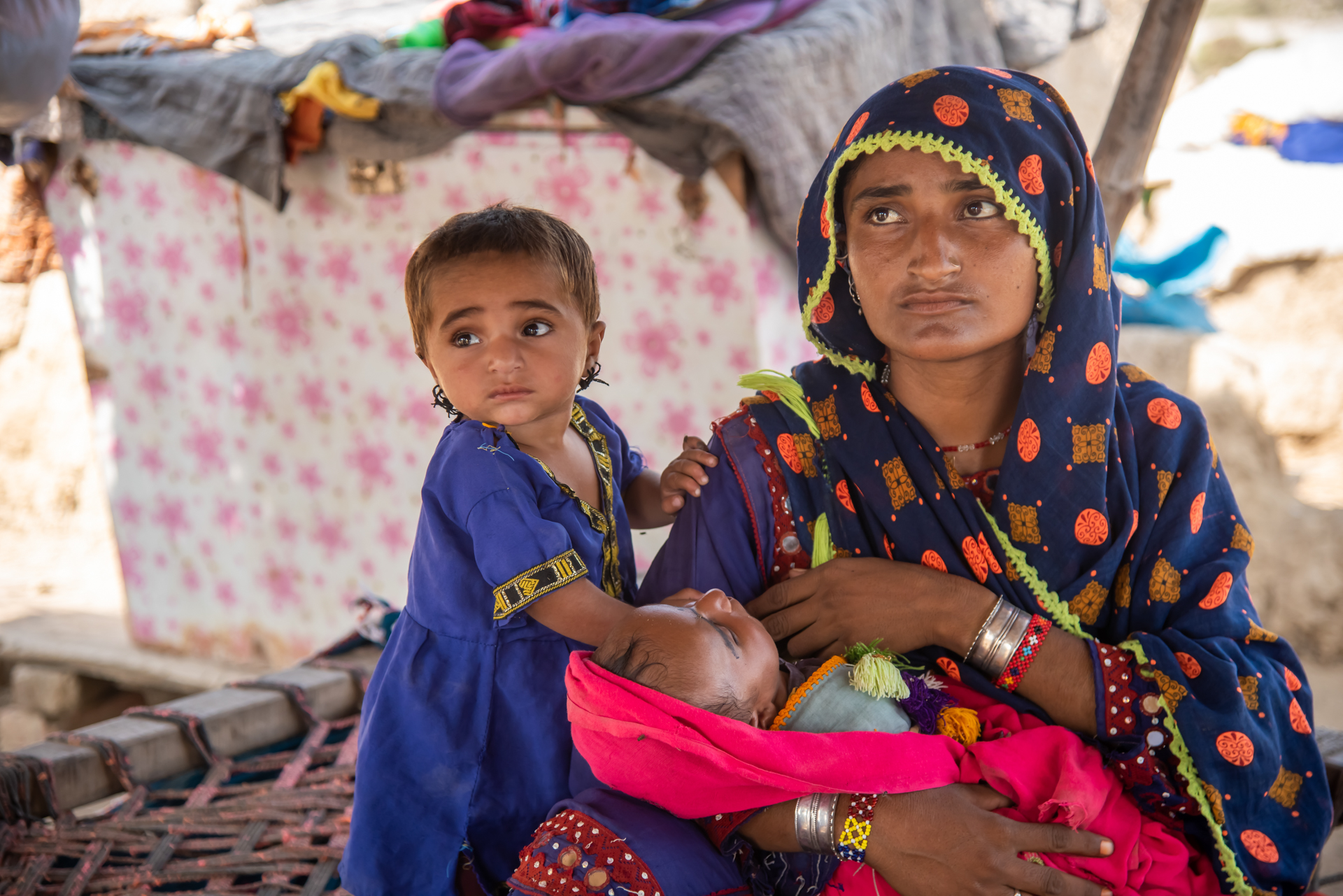
Photo: IOM Pakistan 2022/Muhammad Zeeshan Siddiqui
"I'm filled with worries about the world my children will inherit, given the constant destruction of our village by floods," Gul Khatoon expressed. She was seven months pregnant when the devastating floods hit in 2022, displacing her from her village. She ended up giving birth in a makeshift roadside shelter without any medical assistance or proper care.
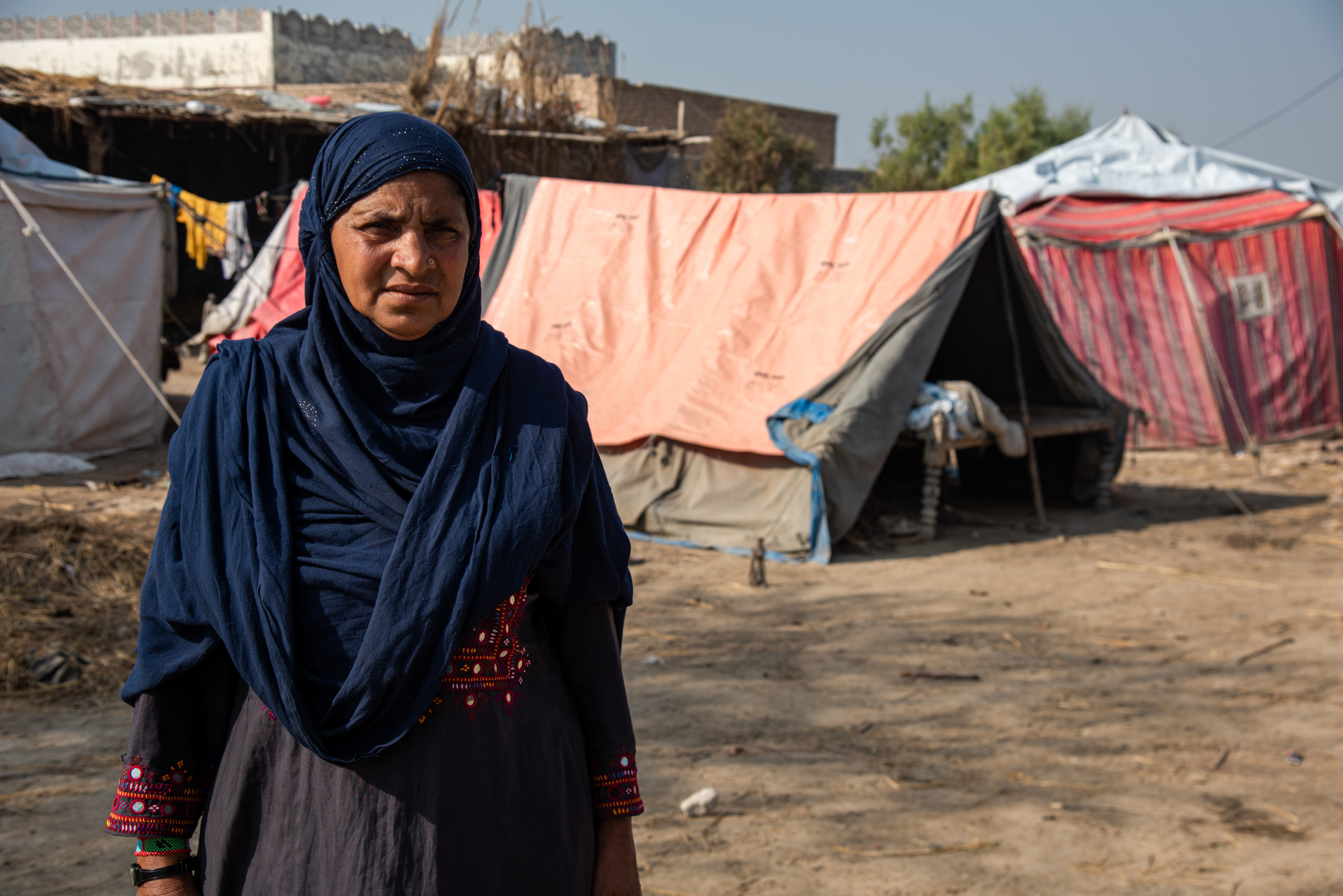
Photo: IOM Pakistan 2023/Muhammad Zeeshan Siddiqui
"Before the floods, I could afford to buy whatever I wanted for my little girls – henna, shoes and clothes. But now, I can't get them anything. I don't know when things will return to normal. Even when they do, it’s only a matter of time before we face adversity again,” shared Abida, a single mother of five children.
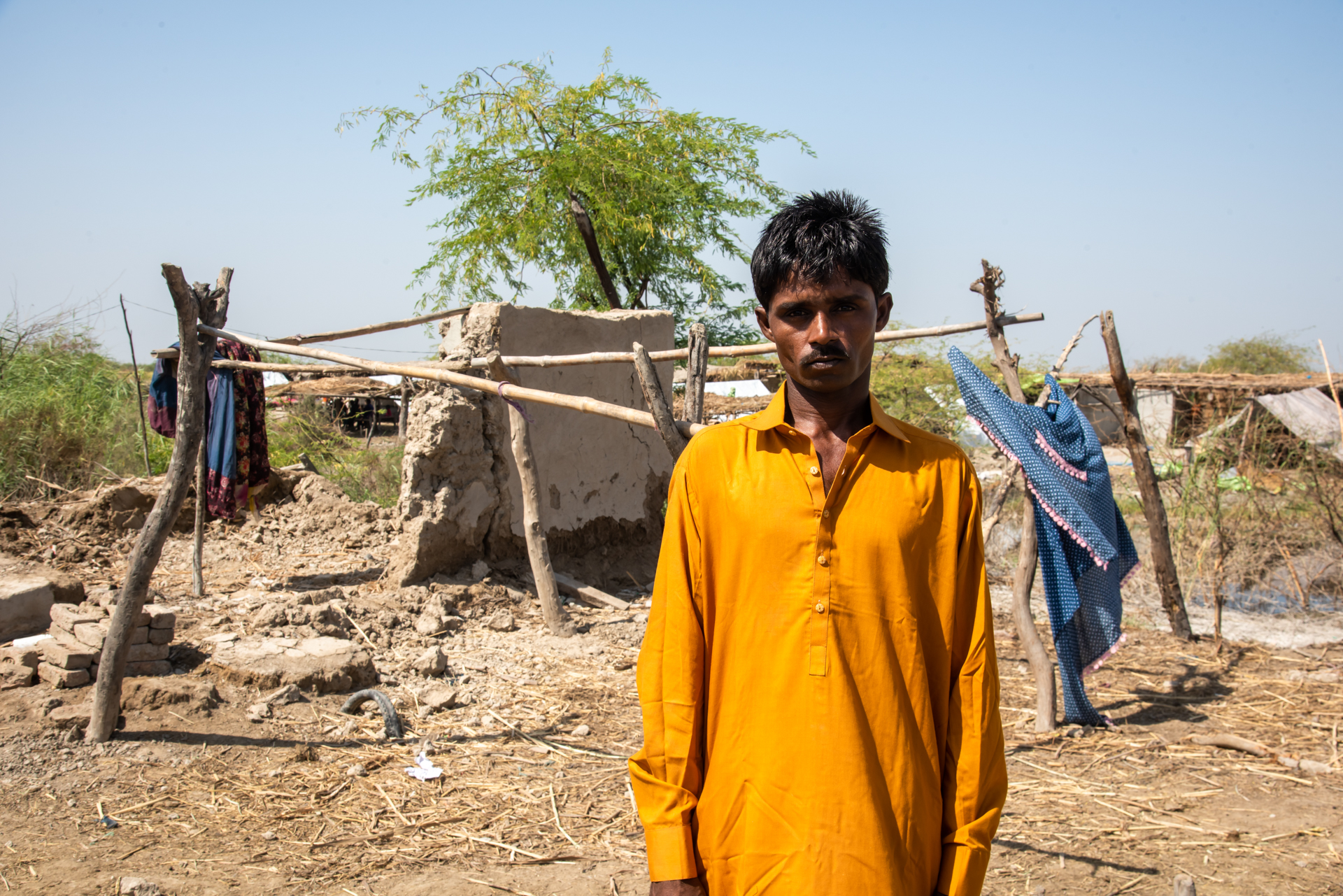
"Rebuilding is meaningless if I have to do it over and over again." Arjun recounts how his house in district Badin has been completely destroyed thrice due to the floods. The constant cycle of destruction and rebuilding has left him feeling anxious and overwhelmed.
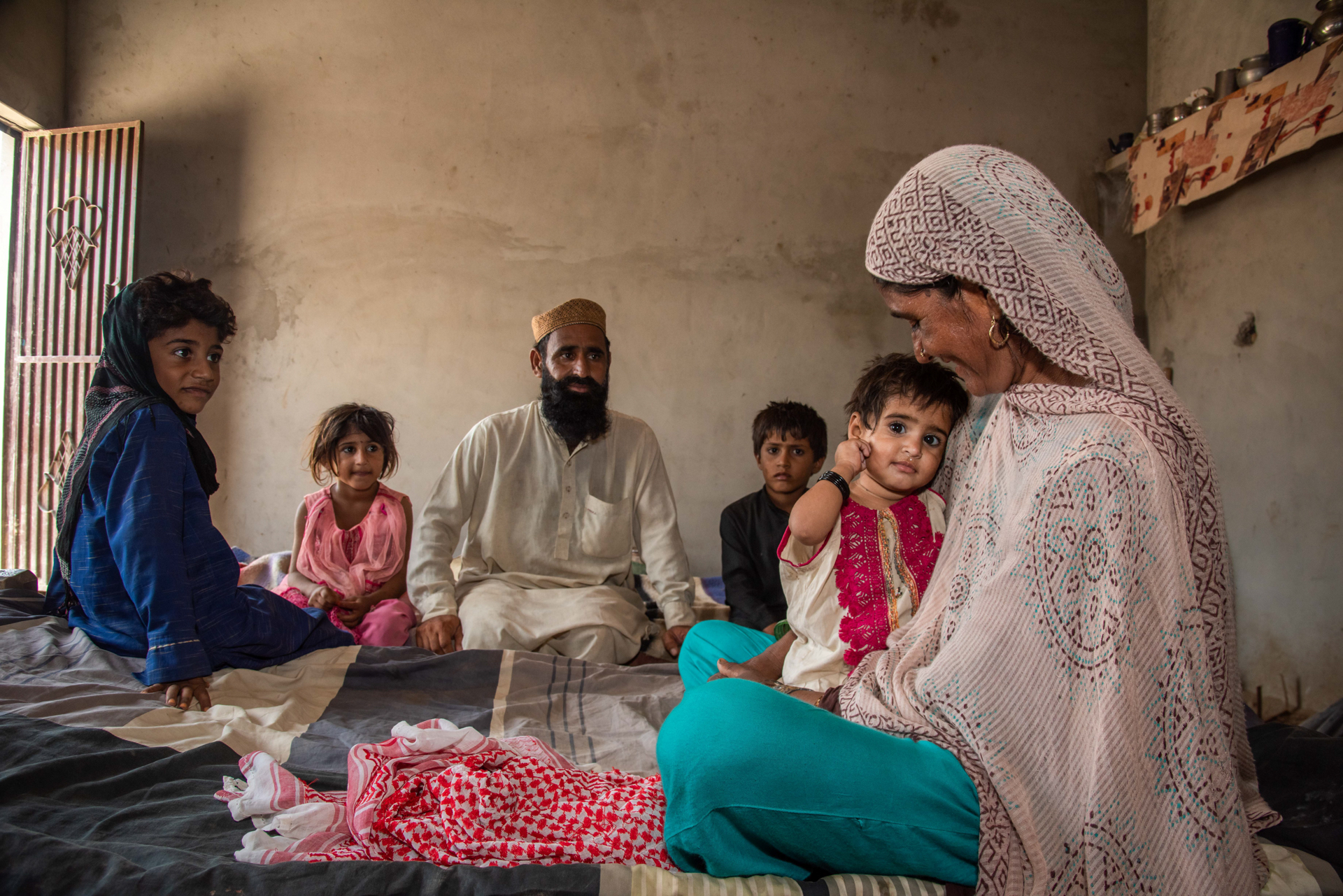
“We are poor. Our home was completely destroyed by the floods. I would not have had the financial means to rebuild the house had it not been for IOM’s support,” explained Qari Saeed, echoing the sentiments of many in his village in D.I. Khan, in the north-western region of Pakistan. They fear being trapped in a cycle of vulnerability, and while some were able to build back better, many are concerned about having to repeatedly rebuild their homes only to see them washed away again by the floods.
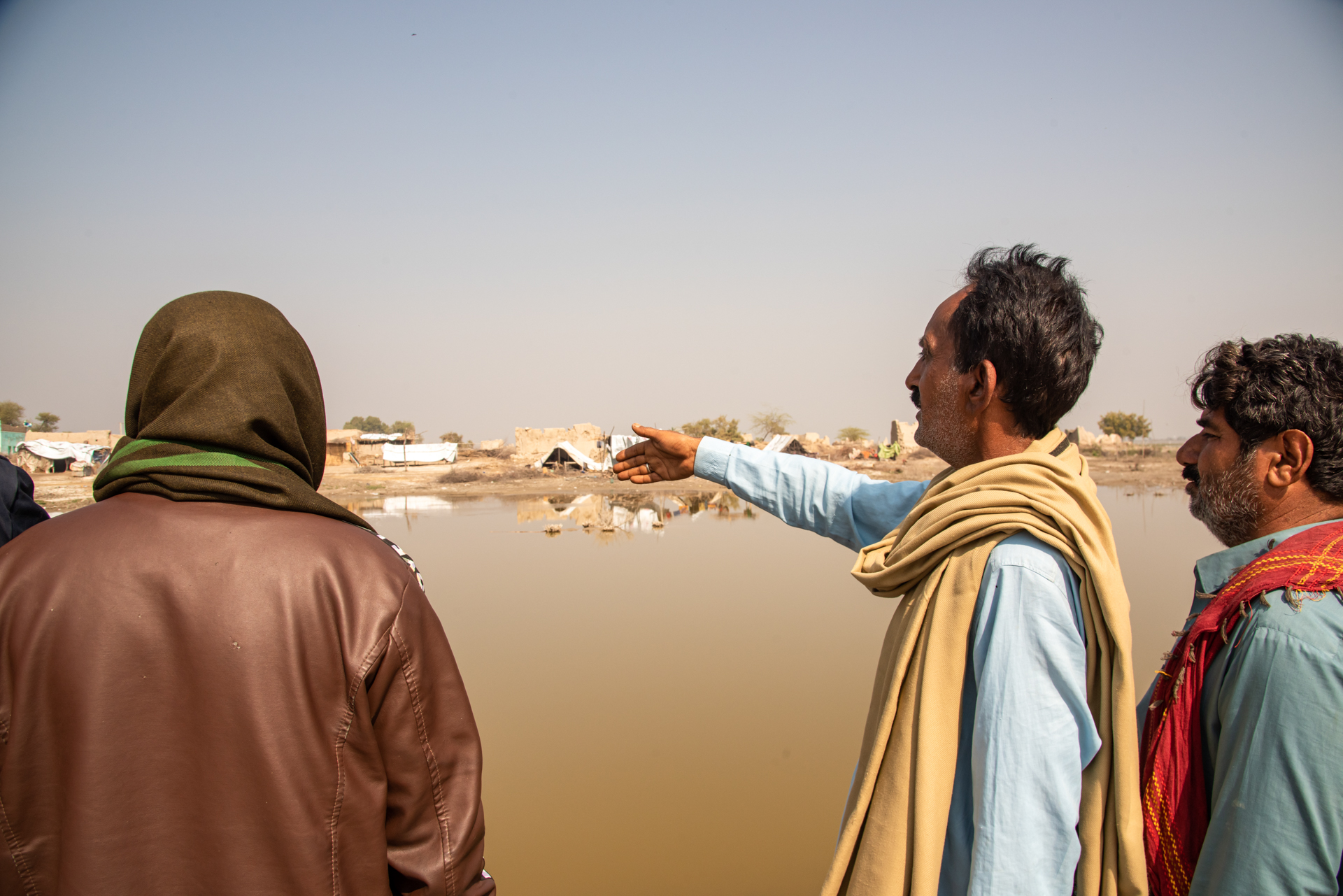
Photo: IOM Pakistan 2023/Muhammad Zeeshan Siddiqui
"Our village was once thriving, but now it lies in ruins. Our land, once fertile, has been devastated. We can only hope that divine intervention will protect us from the relentless onslaught of these unforgiving rain patterns. Our fate hangs in the balance," reflected the community elders in district Shikarpur as they surveyed the remnants of their village.
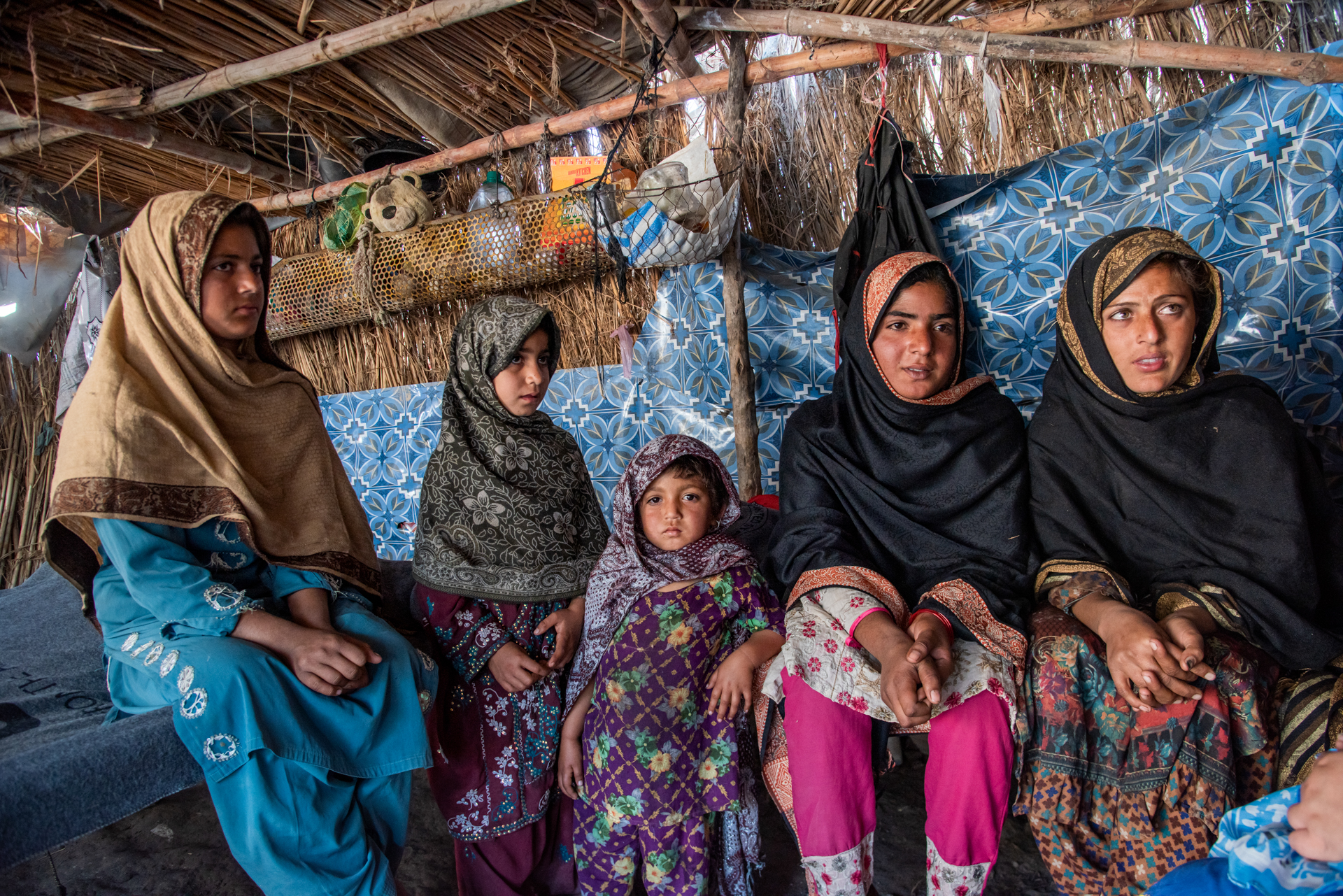
"Some days, my back aches so much from lifting water that I can barely move. With each step, I wonder what it will be like if I have to keep doing this for the rest of my life," Sania, who is 15, walks several miles each day along with her cousins to collect clean drinking water. This grueling task is both physically and mentally excruciating.
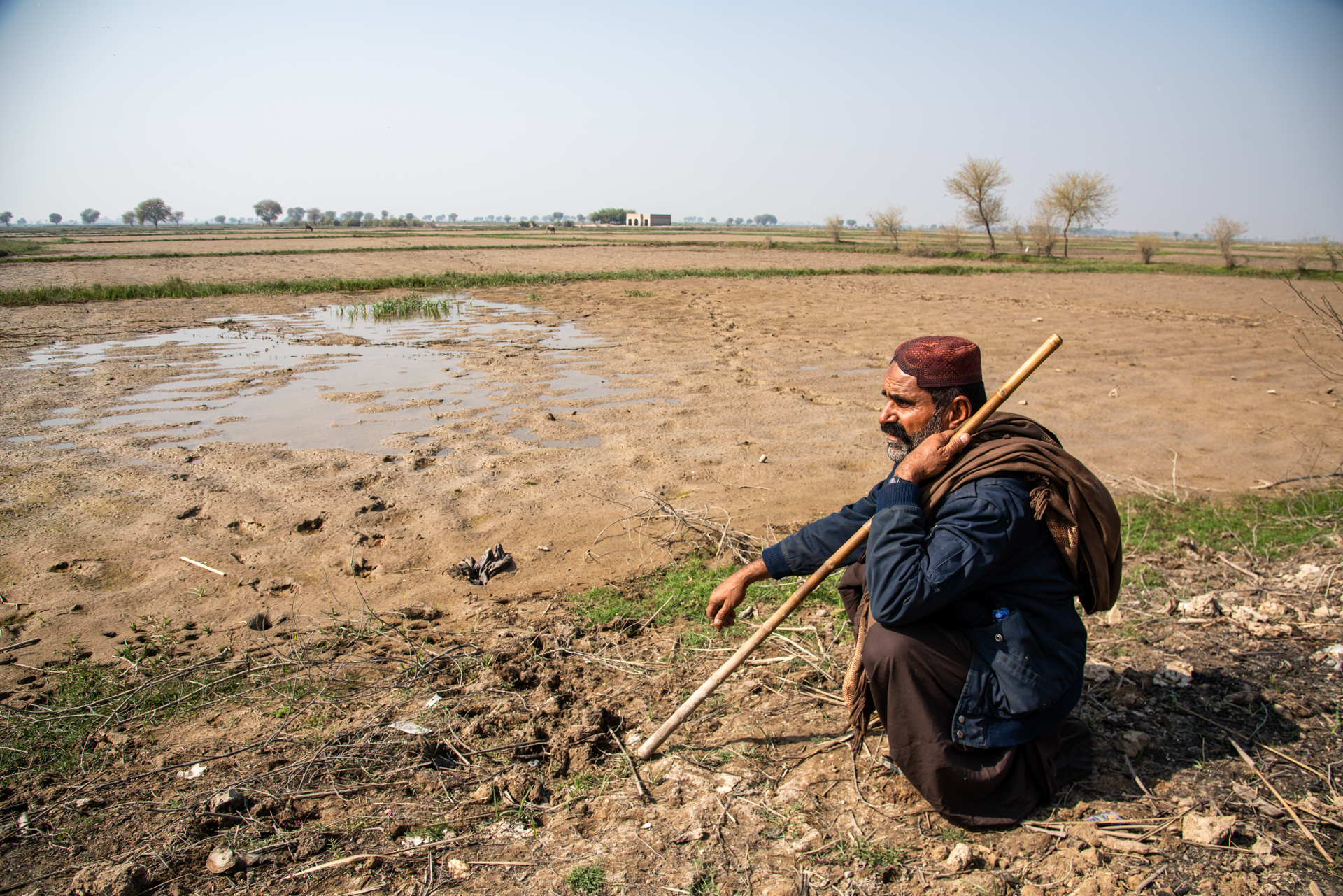
"As a father of eight, it's my duty to provide for my family, but I find myself powerless in the wake of these floods. If another flood comes next year, all our hard work to rebuild will go to waste," Ali Bux reflects sadly as he witnesses his once fertile land crumbling.
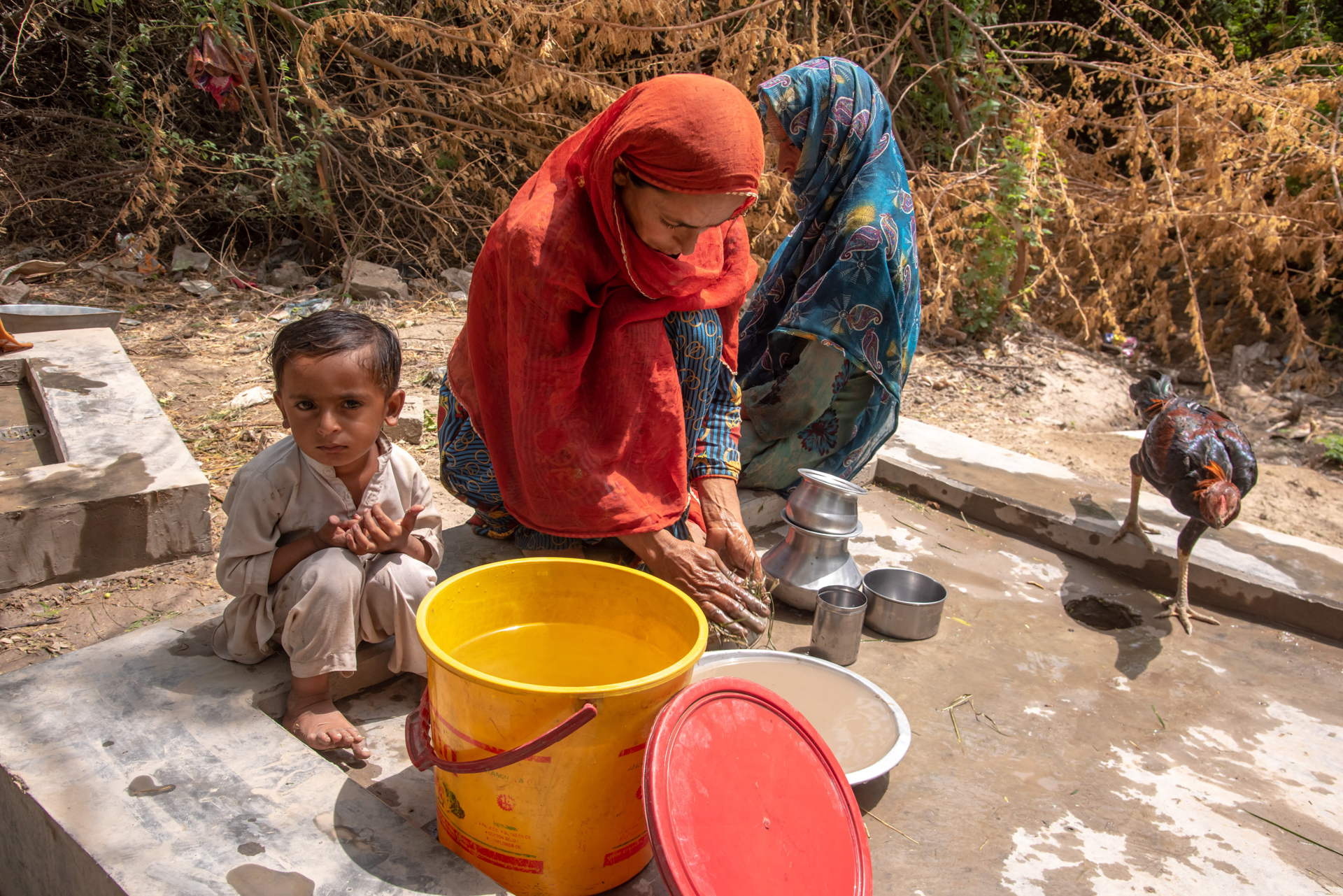
For several weeks, four-year-old Ali cried in fear that he might get bitten by a snake during the nights they spent in a roadside shelter following the floods. This year, on Eid, he prayed for a red bike and a dry monsoon season. Concerns about future floods and their consequences weigh heavily on the minds of the children, just as they do on their parents'.
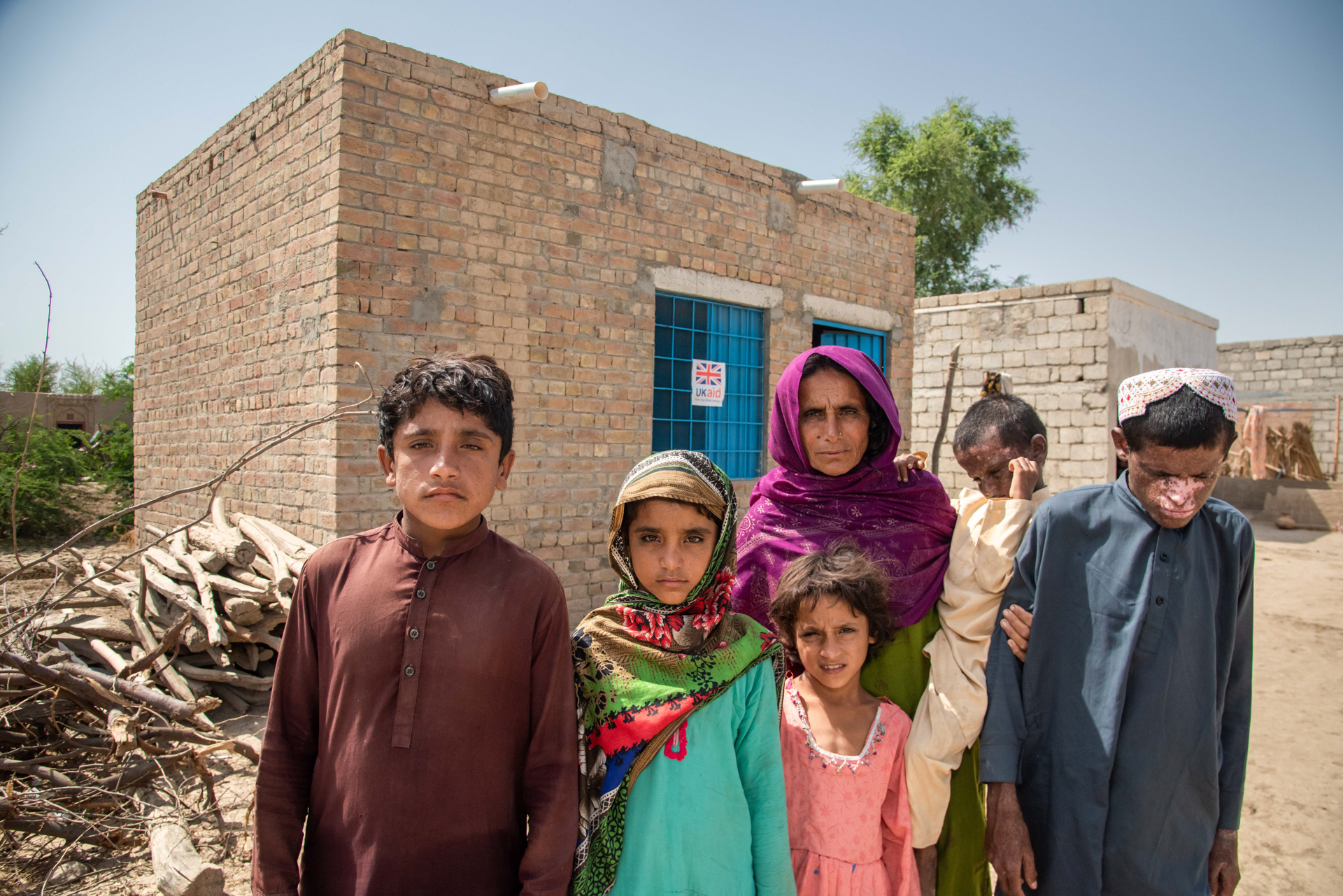
Responsible for her six children, two of whom have disabilities, and with her husband having passed away six years earlier, Fatima Bibi worries about her children's future, especially when she will not be there to care for them forever in the event of recurring floods.
This story is written by Maha Akbar, Communications Officer, IOM Pakistan.

Thank you for visiting nature.com. You are using a browser version with limited support for CSS. To obtain the best experience, we recommend you use a more up to date browser (or turn off compatibility mode in Internet Explorer). In the meantime, to ensure continued support, we are displaying the site without styles and JavaScript.
- View all journals
- Explore content
- About the journal
- Publish with us
- Sign up for alerts
- NEWS Q&A
- 09 September 2022
Pakistan’s floods have displaced 32 million people — here’s how researchers are helping
- Smriti Mallapaty
You can also search for this author in PubMed Google Scholar
With more than a one-third of Pakistan affected by flooding, millions of people are in need of food, shelter and medical care. Researchers, along with the government, international aid agencies and local organizations are racing to provide assistance ahead of more rain predicted this month.
Access options
Access Nature and 54 other Nature Portfolio journals
Get Nature+, our best-value online-access subscription
24,99 € / 30 days
cancel any time
Subscribe to this journal
Receive 51 print issues and online access
185,98 € per year
only 3,65 € per issue
Rent or buy this article
Prices vary by article type
Prices may be subject to local taxes which are calculated during checkout
Nature 609 , 667 (2022)
doi: https://doi.org/10.1038/d41586-022-02879-2
This interview has been edited for length and clarity.
Related Articles

- Environmental sciences
- Climate sciences

China promises more money for science in 2024
News 08 MAR 24
The community should also support Palestinian scientists
Correspondence 21 NOV 23

One-third of Indian STEM conferences have no women
News 15 NOV 23

Diana Wall obituary: ecologist who foresaw the importance of soil biodiversity
Obituary 10 MAY 24

Reinvent oil refineries for a net-zero future
Editorial 08 MAY 24
Why it was right to reject the Anthropocene as a geological epoch
Correspondence 30 APR 24

How ignorance and gender inequality thwart treatment of a widespread illness
Outlook 09 MAY 24

Bird flu in US cows: where will it end?
News 08 MAY 24

Discovery of potent small-molecule inhibitors of lipoprotein(a) formation
Article 08 MAY 24
Faculty Positions at the Center for Machine Learning Research (CMLR), Peking University
CMLR's goal is to advance machine learning-related research across a wide range of disciplines.
Beijing, China
Center for Machine Learning Research (CMLR), Peking University
Faculty Positions at SUSTech Department of Biomedical Engineering
We seek outstanding applicants for full-time tenure-track/tenured faculty positions. Positions are available for both junior and senior-level.
Shenzhen, Guangdong, China
Southern University of Science and Technology (Biomedical Engineering)
Southeast University Future Technology Institute Recruitment Notice
Professor openings in mechanical engineering, control science and engineering, and integrating emerging interdisciplinary majors
Nanjing, Jiangsu (CN)
Southeast University
Staff Scientist
A Staff Scientist position is available in the laboratory of Drs. Elliot and Glassberg to study translational aspects of lung injury, repair and fibro
Maywood, Illinois
Loyola University Chicago - Department of Medicine
W3-Professorship (with tenure) in Inorganic Chemistry
The Institute of Inorganic Chemistry in the Faculty of Mathematics and Natural Sciences at the University of Bonn invites applications for a W3-Pro...
53113, Zentrum (DE)
Rheinische Friedrich-Wilhelms-Universität
Sign up for the Nature Briefing newsletter — what matters in science, free to your inbox daily.
Quick links
- Explore articles by subject
- Guide to authors
- Editorial policies
- Get Involved
Pakistan: Flood Damages and Economic Losses Over USD 30 billion and Reconstruction Needs Over USD 16 billion
Post-Disaster Needs Assessment calls for urgent support to implement a Recovery and Reconstruction that ‘Builds Back Better’
October 27, 2022
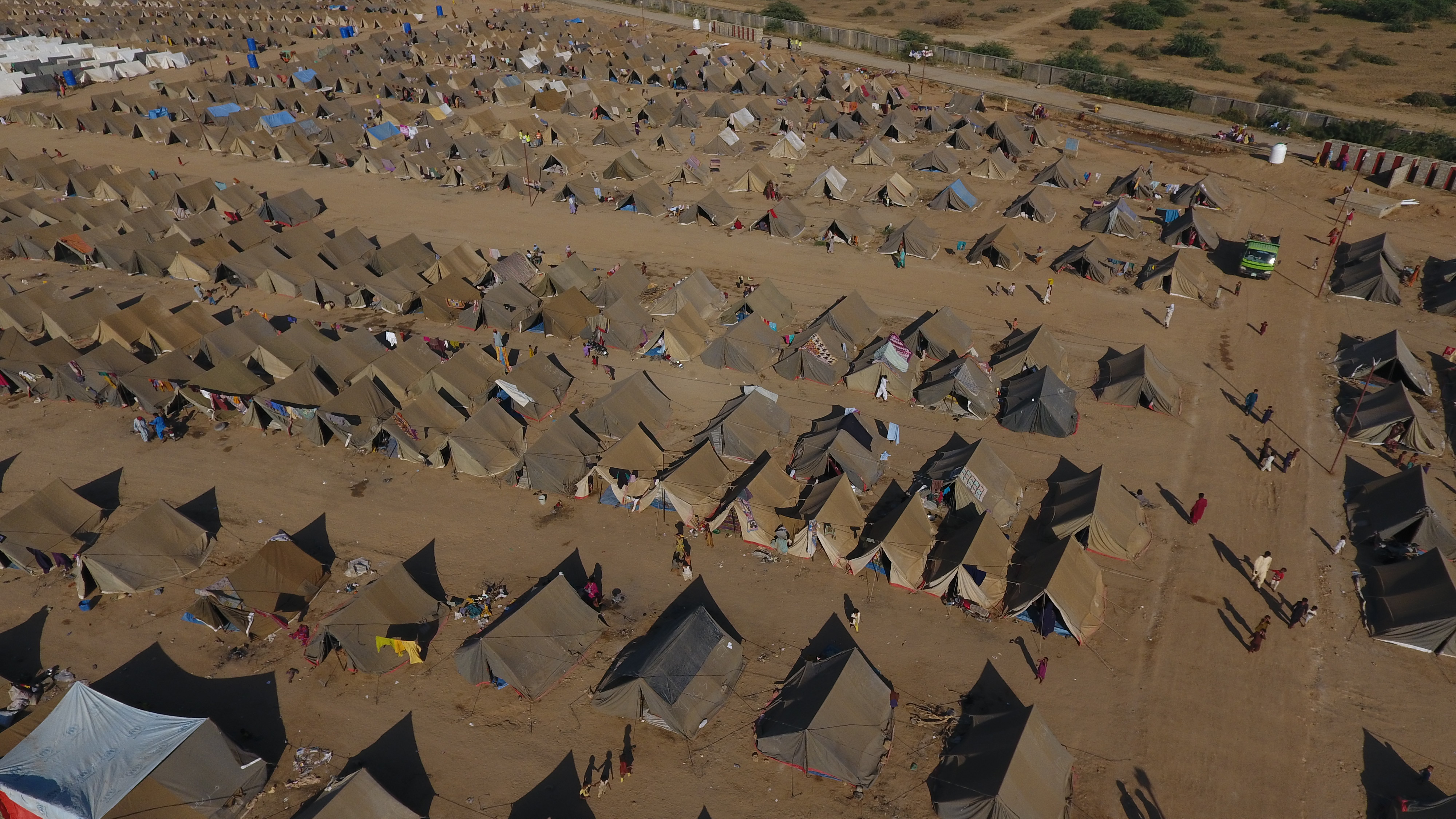
Tent city in Malir, Karachi for flood affected communities.
ISLAMABAD, October 28, 2022 - A damage, loss, and needs assessment following the unprecedented floods in Pakistan calls for ‘ building back better ’, based on the principles of the poor first, transparency, inclusion, and climate resilience . The assessment estimates total damages to exceed USD 14.9 billion, and total economic losses to reach about USD 15.2 billion. Estimated needs for rehabilitation and reconstruction are at least USD 16.3 billion , not including much needed new investments to strengthen Pakistan’s adaptation to climate change and overall resilience to future climate shocks, or reconstruction needs of affected private entities.
Housing; Agriculture and Livestock ; and Transport and Communications sectors suffered the most significant damage, at USD 5.6 billion, USD 3.7 billion, and USD 3.3 billion, respectively. Sindh is the worst affected province with close to 70 percent of total damages and losses, followed by Balochistan, Khyber Pakhtunkhwa, and Punjab.
The Ministry of Planning, Development and Special Initiatives led the Post-Disaster Needs Assessment (PDNA) , which was conducted jointly with the Asian Development Bank (ADB), the European Union (EU), the United Nations agencies with technical facilitation by the United Nations Development Programme (UNDP), and the World Bank.
The PDNA, in addition to estimating damages, economic losses and recovery and reconstruction needs, also assesses broader macro-economic and human impacts and recommends principles along which to develop a comprehensive recovery and reconstruction framework.
The floods affected 33 million people and more than 1730 lost their lives . They are particularly impacting the poorest and most vulnerable districts. The situation is still evolving, with flood waters stagnant in many areas, causing water-borne and vector-borne diseases to spread, and more than 8 million displaced people now facing a health crisis .
The crisis thus risks having profound and lasting impacts on lives and livelihoods. Loss of household incomes, assets, rising food prices, and disease outbreaks are impacting the most vulnerable groups. Women have suffered notable losses of their livelihoods, particularly those associated with agriculture and livestock.
The PDNA Human Impact Assessment highlights that the national poverty rate may increase by 3.7 to 4.0 percentage points, potentially pushing between 8.4 and 9.1 million more people below the poverty line .
Multidimensional poverty can potentially increase by 5.9 percentage points, implying that an additional 1.9 million households are at risk of being pushed into non-monetary poverty.
Compounding the existing economic difficulties facing the country, the 2022 floods are expected to have a significant adverse impact on output, which will vary substantially by region and sector. Loss in gross domestic product (GDP) as a direct impact of the floods is projected to be around 2.2 percent of FY22 GDP . The agriculture sector is projected to contract the most, at 0.9 percent of GDP. The damage and losses in agriculture will have spillover effects on the industry, external trade and services sectors.
The Government is providing immediate relief to the impacted communities and supporting the early recovery, while aiming to ensure macroeconomic stability and fiscal sustainability. Moving forward, as recovery and reconstruction spending rises, the loss in output could be mitigated. Yet, significant international support will be needed to complement Pakistan’s own commitment to increase domestic revenue mobilization and save scarce public resources, and to reduce the risk of exacerbating macroeconomic imbalances.
Although the early loss and damage estimates may increase as the situation is continuously evolving on the ground, the PDNA lays the groundwork for an agenda for recovery and reconstruction that is designed to build back a better future for the most affected people in Pakistan . While the recovery will require massive efforts for the rehabilitation and reconstruction of damaged infrastructure, buildings and livelihoods, it will also be an opportunity to strengthen institutions and governance structures.
The report puts forth recommendations for developing a comprehensive recovery framework. While the primary focus will be on the affected areas, such framework presents an opportunity to embed systemic resilience to natural hazards and climate change in Pakistan’s overall development planning.
This tragic disaster can be a turning point, where climate resilience and adaptation, increased domestic revenue mobilization and better public spending, and public policies and investments better targeted to the most vulnerable populations; all figure at the core of policy making going forward.
In the short term, targeted mechanisms such as social assistance and emergency cash transfers, provision of emergency health services, and programs to restore shelter and restart local economic activities, particularly in agriculture, should be prioritized. Reconstruction and rehabilitation should rest on key principles of : participatory, transparent, inclusive, and green recovery for long-term resilience—“ building back better ”; pro-poor, pro-vulnerable, and gender sensitive, targeting the most affected; strong coordination of government tiers and implementation by the lowest appropriate level; synergies between humanitarian effort and recovery; and a sustainable financing plan.
Given Pakistan’s limited fiscal resources, significant international support and private investment will be essential for a comprehensive and resilient recovery . The Pakistani authorities are committed to accelerate reforms to generate additional domestic fiscal resources and improve efficiency and targeting of public spending. Beyond the immediate needs of floods reconstruction, these reforms, while protecting the most vulnerable, will be important to generate fiscal space to invest more broadly into more climate-resilient infrastructure and adaptation to climate change, as well as to build buffers to face future shocks, while addressing macroeconomic imbalances. This commitment of the Government will also be key to mobilize further international support as well as to unlock private sector sources of financing—both of which will be absolutely critical to face the current climate change-induced shock.
The ADB, the EU, the UNDP and the World Bank are fully committed to working with the Government and people of Pakistan during the ensuing recovery phase, and to increase the country’s climate resilience.
For additional information, please contact:
ADB: Ismail Khan at [email protected] EU: [email protected] UNDP: Tabindah Anwar at [email protected] or +92 (51) 835 5650 World Bank: Mariam Altaf at [email protected] or +92 (51) 9090000
Floods are tipping Pakistan into a food crisis
Farmland bigger than the Czech Republic is flooded. Fresh crops are delayed, supply chains disrupted. Now hunger looms.

The catastrophic floods in Pakistan have pushed the country to the brink. These floods follow the COVID-19 pandemic, rising inflation and the most severe heatwave the country has faced in more than 60 years.
When he visited in September, United Nations Secretary-General António Guterres said he had “ never seen climate carnage on such scale ”.
Keep reading
How food and chopstick skills are helping ease us-china tensions, the surfer chef behind south africa’s first fine dining halal restaurant, why are pakistan’s wheat farmers protesting against the government, about 282 million people faced acute hunger last year: un-led report.
But the awful reality is that this is just the beginning. Another big crisis birthed by the floods faces Pakistan — that of food insecurity.
Pakistan already has some of the highest levels of malnutrition in the world. With the entire supply chain damaged in recent weeks, the country is likely to witness increased vulnerability to malnutrition, especially among women, young people and children.
Ensuring access
Across 81 districts, a total of 78,000 sq km (30,000 sq miles) of farmland were flooded. That’s an area bigger than the entire Czech Republic. More than 80 percent of crops across the country were damaged , according to the government. The Sindh province, which produces a considerable share of the country’s food, is one of the worst affected.
Thousands of hectares of standing food crops like rice, onions, tomatoes and other vegetables have been destroyed. More than 6,000km (3,728 miles) of roads and bridges have been damaged, causing significant disruptions to the transport of the food that has survived.
An assessment done in September by the International Rescue Committee (IRC) and its partners found that more than 70 percent of individuals interviewed in the Khyber Pakhtunkhwa region reported difficulty accessing any food, let alone nutritious food.
Keeping food affordable
The United Nations estimates the economic loss due to the floods stands at an enormous $40bn. This in a country reeling from steep inflation, which was already running at a 14-year high of almost 25 percent in July before the floods hit. It’s worse now: Food prices in the affected regions increased three to five times in just a few weeks.
The import of vegetables from neighbouring countries, particularly Afghanistan and Iran, will certainly help. However, the government will have to strictly regulate prices along the supply chain, so food remains affordable for everyone, especially the most vulnerable.
It isn’t just causing problems in Pakistan, which is the world’s eighth-largest producer of wheat. With one-third of the country under water, delays in sowing wheat — which normally happens in November and December — seem inevitable. Draining the flood waters and rejuvenating the soil is going to take several months.
In July, Pakistan agreed to sell 120,000 metric tonnes of wheat towards the World Food Programme’s aid efforts in Afghanistan. Pakistan is also a key transit route to send food into Afghanistan. But the floods have made it much harder to transport aid to Pakistan’s landlocked neighbour, the UN warned in September. Afghanistan is already facing unprecedented levels of hunger and food shortages.
Rebuilding must start now
At least 33 million people have been directly affected by the floods in both rural and urban areas.
In rural regions, the government’s efforts need to focus on draining floodwaters from agricultural lands for the sowing of winter crops. This will save the country from sinking into a prolonged food security crisis.
In urban areas, the government must keep a check on further price rises caused by the cost of imports and supply chain disruptions.
Many informal markets, where people sell food items on pushcarts, or small shops made out of mud structures in low-income areas, have been completely destroyed — along with the livelihoods of those who worked there. The government needs to rehabilitate these markets, creating better infrastructure to make them more resilient to future disasters.
Rapid government action on all of this is critical — and it must start now. It’s possible to envisage riots and other forms of law-and-order situations caused by the enormous pressure on food systems.
We, at the Global Alliance for Improved Nutrition (GAIN), have been working in Pakistan since 2007. We are in the middle of an assessment that will guide our own interventions aimed at rehabilitating some food marketplaces in the worst affected areas.
Future uncertain
Of course, these devastating floods are only the latest evidence of the ways Pakistan and many other countries in the Global South are bearing the brunt of the Global North’s disproportionate abuse of the climate for centuries.
Leading donors must step forward and respond to the joint appeal of the UN and the Pakistani government for $816m — a steep increase from the initial $160m they had requested — needed for immediate relief.
But even once the current crisis passes, the outlook is grim for my country. In the World Bank’s 2021 Climate Risk Country Profile , projections for Pakistan over the next 10 years suggest “yield declines in many key food and cash crops, including cotton, wheat, sugarcane, maize and rice”.
What’s so desperately sad is that women and children in countries like mine are the ones who will suffer the most and end up with the least food on their plates.
As the government of Pakistan and development agencies try to restore the supply chain and rebuild food markets, they must also focus on social safety nets for these segments of the population. The government must also strengthen existing social protection programmes to address the nutrition needs of people with low incomes.
The international community should also help secure the future by committing to a significant increase in its support to help communities adapt to increasingly extreme climates.
The government must ensure the funds it receives are used properly, both to address the immediate challenges spawned by the floods and to rebuild intelligently for when we are inevitably hit by the next large climate event.
Pakistan is at a crossroads. It does not have to drown or go hungry.
The views expressed in this article are the author’s own and do not necessarily reflect Al Jazeera’s editorial stance.
Essay on Flood in Pakistan 2024 with Outline
Basically, natural disasters mean the unpredicted damage which occurs naturally. These types of disasters are happening across the world that caused huge destruction which sometimes results in the loss of human lives. Thus, no one in the whole world can stop them but it is found behind these disasters there are serious natural reasons. Flood is one of the common natural disasters. The flood causes a considerable amount of destruction by the abundant flowing of water. Some floods occur unexpectedly and move away quickly. During 2024 the best essay that covers all the related info on the topic of the flood in Pakistan with an outline is here in detail.
In Pakistan, floods are ordinary as the territory of Pakistan contains rivers. Unluckily, Punjab and Sindh are heavily affected by the flood. During the monsoon season, the rivers and canals of the these provinces filled up at an enormous rate by heavy rainfall due to which the river basins go down into the water. In Sindh, hurricanes and massive winds may sometimes carry seawater which is another reason for flooding. In addition, heavy rainfall and ice melting are the main causes of the flood.
Every year in Pakistan flood causes huge devastation. The after effects of the flood are more than worse. People who used to live near the river banks lose their lives, their houses got collapsed, and their possessions and properties got ruined. Meanwhile, a large number of people have to shift towards a safe place. The affected people live without shelter, food.
They even have no basic necessities of life. By drinking unclean water, the victims of flood suffer from many diseases. Thus, the health issue is also created by the flood. The helpless people suffer from malaria, measles, diarrhea. Furthermore, the means of communication and transportation are also badly affected. It wipes away even the heavy items. Every disaster has its end whereas in Pakistan flood disaster has become the dilemma of each year.
The government of Pakistan every year makes plans and efforts to avoid this natural disaster. The Government should endorse money for longer-term loans and gratuitous reliefs. The government should draw its attention to making the bigger dams and special ways must be adopted that transfer the overflow of water into the dry areas or into the lakes and river.
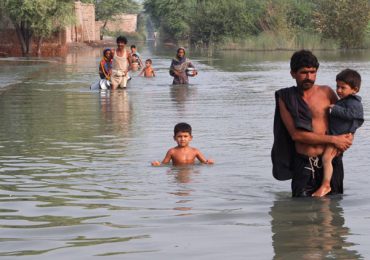
The government has made relief committees and asks for shelter, food, and clothes. Pakistan’s army is appointed to help, assist, and support the victims of the flood. People on their behalf help their brothers by giving donations and also pursued other people to help the needy people.
Leave a Reply
Your email address will not be published. Required fields are marked *
- Dream World Karachi Ticket Price 2024 per Person, Membership for…
- Suzuki Alto New Model 2024 Price in Pakistan 660CC 800CC…
- Kashees Salon Price List 2024
- Samzu Water Park Karachi Ticket Price 2024
- Fiat Tractor Price in Pakistan 2024 640 480
- Ravindra Jadeja Mustache Style
- Best Car Racing Games For Pc 2015 List
- Gomal Medical College Merit List 2024
- Sindh University Fee Structure 2024 on Merit, Self Finance
- Bise Lahore Board 9th Class Roll Number No Slip 2016
- 800cc Cars in Pakistan 2024 Price Launch Date Specs
- KITE Karachi entry test result 2024 for admission BBA, BCS
- Leisure Club Sale 2024 Online Shopping
- Hotels in Karachi Pakistan
- Unemployment In Pakistan Essay in English

Content Search
Confronting climate anxiety: one year after the floods in pakistan.

This photo essay was originally published by Al Jazeera in October 2023.
Pakistan, 16 November 2023 – One year ago, Pakistan experienced unprecedented floods. Over 33 million people were directly affected, with a staggering 20.6 million requiring urgent humanitarian assistance. The consequences were dire – 7.9 million people were displaced, and over 2 million houses were destroyed.
Although the water has receded, one year later, the scars of the natural hazard remain fresh. Over 1.5 million people are still displaced. The most basic necessities, such as food and shelter, continue to be out of reach for a large portion of the flood-affected population, more than 40 per cent of whom rely on humanitarian aid for survival.
While the immediate concerns of food, shelter, and water have been largely documented, climate anxiety among flood-affected communities across Pakistan has failed to make headlines.
Although climate anxiety is a newly coined term, it reflects a distress that has long been felt by these communities.
Amidst the increasing threat of climate change, floods in Pakistan have grown more frequent, resulting in some communities facing an unending cycle of displacement and despair. For these communities, the fatigue caused by climate-change-induced disasters has begun to take its toll. They are not only exhausted but also more anxious than ever about the potential threat of cascading disasters.
Men, women and children alike in these flood-affected areas are living in fear of an uncertain future. They grapple with the harsh reality that they lack the necessary preparations to face another flood, and they have no clear plans for shelter should their already fragile homes become uninhabitable.
These communities are in a constant struggle to meet their basic survival needs, and the anxiety about recurrent climate-related disasters adds an additional layer of uncertainty to their lives.
Despite contributing very little to the current global climate breakdown, Pakistan remains one of the countries most vulnerable to the effects of climate change. As the nation grapples with the devastating impact of climate change, climate anxiety will likely continue to rise, especially among the most vulnerable populations.
"I'm filled with worries about the world my children will inherit, given the constant destruction of our village by floods," Gul Khatoon expressed. She was seven months pregnant when the devastating floods hit in 2022, displacing her from her village. She ended up giving birth in a makeshift roadside shelter without any medical assistance or proper care.
"Before the floods, I could afford to buy whatever I wanted for my little girls – henna, shoes and clothes. But now, I can't get them anything. I don't know when things will return to normal. Even when they do, it’s only a matter of time before we face adversity again,” shared Abida, a single mother of five children.
"Rebuilding is meaningless if I have to do it over and over again." Arjun recounts how his house in district Badin has been completely destroyed thrice due to the floods. The constant cycle of destruction and rebuilding has left him feeling anxious and overwhelmed.
“We are poor. Our home was completely destroyed by the floods. I would not have had the financial means to rebuild the house had it not been for IOM’s support,” explained Qari Saeed, echoing the sentiments of many in his village in D.I. Khan, in the north-western region of Pakistan. They fear being trapped in a cycle of vulnerability, and while some were able to build back better, many are concerned about having to repeatedly rebuild their homes only to see them washed away again by the floods.
"Our village was once thriving, but now it lies in ruins. Our land, once fertile, has been devastated. We can only hope that divine intervention will protect us from the relentless onslaught of these unforgiving rain patterns. Our fate hangs in the balance," reflected the community elders in district Shikarpur as they surveyed the remnants of their village.
"Some days, my back aches so much from lifting water that I can barely move. With each step, I wonder what it will be like if I have to keep doing this for the rest of my life," Sania, who is 15, walks several miles each day along with her cousins to collect clean drinking water. This grueling task is both physically and mentally excruciating.
"As a father of eight, it's my duty to provide for my family, but I find myself powerless in the wake of these floods. If another flood comes next year, all our hard work to rebuild will go to waste," Ali Bux reflects sadly as he witnesses his once fertile land crumbling.
For several weeks, four-year-old Ali cried in fear that he might get bitten by a snake during the nights they spent in a roadside shelter following the floods. This year, on Eid, he prayed for a red bike and a dry monsoon season. Concerns about future floods and their consequences weigh heavily on the minds of the children, just as they do on their parents'.
Responsible for her six children, two of whom have disabilities, and with her husband having passed away six years earlier, Fatima Bibi worries about her children's future, especially when she will not be there to care for them forever in the event of recurring floods.
This story is written by Maha Akbar, Communications Officer, IOM Pakistan.
Related Content
Pakistan: monsoon floods - operation update #6 (mdrpk023), climate crisis in pakistan: voices from the ground, pakistan: monsoon floods - operation update #4 (mdrpk023), a difficult lesson from the pakistan floods.
Essay on Floods in Pakistan for Matric, FA, FSC, BA and BSC
Essay on floods in pakistan for the students of matric, fa, fsc, 2nd year, intermediate, ba and bsc.
Here is an essay on Floods in Pakistan for students of Class 10, Class 12 and graduation. Pakistan is a developing country and floods in it are not unusual. This essay will discuss the reason of floods in Pakistan. You can write the same essay under the title Floods in Pakistan essay, Essay on Flood, an essay on flood, an essay on flood disaster.
Floods in Pakistan Essay for Class 10, Class 12 and Graduation
The recent floods in Pakistan were a calamity. They visit our country quite frequently. We live in the modern age, which is remarkable for its scientific advancement but man has failed to overcome floods completely. However, we can set aside the adverse results of the floods to some extent. Floods destroy everything which man achieves after a struggle of many years. They are a horrible thing. They destroy houses and buildings. They uproot the electric and telephone poles. They render thousands of people homeless.
In Punjab, the recent floods played a havoc unknown in history. Almost, all the rivers overflowed their banks and destroyed everything. The villages of Lahore, Dera Gazi Khan, Jhang, Multan and Sargodha were submerged in water. People saved their lives by climbing up the trees. The villagers were sleeping in their homes when the water of the flooding river entered their homes and caused an alarm. They were caught unawares. They rushed out of their homes without taking with them their goods and articles of the house. Epidemics broke out in the villages. Crops were destroyed. Fertile land turned barren and dry. The whole system of communication was paralysed for many days. People saved their lives by swimming in the Water. Many of them climbed up the trees. The army was called in. It was due to the sincere and dedicated efforts of the young men of the army that the lives of many flood affectees were saved. The entire machinery of Government tried its best to set aside the adverse effects of the flood. Relief centres were set up in every town, city and capital. The rich and well-to-date people came forward to help their affected brothers. The causes of the flood are many.
First, they are caused by heavy rainfall in monsoons.
Secondly, the snow on the hills begins to melt in the summer heat. The rivers get swollen. When this continues for some time, the waters rise beyond the banks of the rivers and overspread the neighbouring ground.
Thirdly, the beds of the river are not very deep. That is why they overflow very soon.
Fourthly, all the rivers of Pakistan enter our territory from India. India controls all the rivers. She has made many dams on these rivers. She lets loose a huge quantity of water into our rivers out of revenge. This cannot be controlled by our own efforts unless India cooperates with us.
Last year, l witnessed the scene of a flood in my village. The river Ravi which flows by a village was in flood. It had been raining ceaselessly for over a week. Away on the hills, it had been raining for almost a month. The terrible day came. The river Ravi overflowed its banks and there was water everywhere. There was every fear that our village would be washed away. We brought out cattle to the verandah for safety. We went to bed, but could not sleep for fear of being washed away.
The rain stopped at night. The creaking of frogs, the cries of the cattle and the shouts of men filled the air with fright. A chill wind was blowing. Our courtyard was filled with water. It was almost knee-deep. The water was still rising. Our cattle were drowned in the water. We managed to climb up the trees and stayed there for twenty-four hours. We saved our lives with great difficulty. We spent a very difficult and uncomfortable time there. The helicopters of the army reached us and took us away to a relief centre. We spent there many days and nights in the open. After eight days, the news was brought that the water of the river had gone low considerably. We came to our village and built our house again. We had a serious financial loss in our life. Our cattle and crops were taken away by the floods. We cannot forget the terrible time we had while this flood.
essay on Floods in Pakistan is important for Pakistani students. However, you should check Essay on Beauties of Nature .
- More In English Essays
Essay Writing 101: The Basics That Every Writer Should Know

Students and Social Service Essay with Quotations

Load Shedding in Pakistan Essay – 1200 Words
October 4, 2020 at 10:43 pm
September 18, 2022 at 9:50 am
acha hai bahi
Kashaf Ghaffar
September 20, 2022 at 7:23 pm
don’t use word she for india.
October 22, 2022 at 6:29 pm
Amazing content. Thank you for sharing.
Leave a Reply Cancel reply
Your email address will not be published. Required fields are marked *

- Privacy Policty
- Terms of Service
- Advertise with Us

Pakistan records ‘wettest April’ in more than 60 years
Pakistan has experienced its “wettest April since 1961”, receiving more than twice as much rain as usual for the month, the country’s weather agency has said.
April rainfall was recorded at 59.3mm (2.3 inches), “excessively above” the normal average of 22.5mm (0.9 inches), the metrology department said in its monthly climate report released late on Friday.
The highest rainfall was recorded in the southwestern province of Balochistan with 437 percent more than average.
At least 144 people also died in the thunderstorms and house collapses due to heavy rains in April.
The largest death toll was reported in northwestern Khyber Pakhtunkhwa, where 84 people died, including 38 children, and more than 3,500 homes were damaged.
While much of Asia is sweltering due to heatwaves, Pakistan’s national monthly temperature for April was 23.67 degrees Celsius (74.6 degrees Fahrenheit), 0.87C lower than the average of 24.54C, the report added.
“Climate change is a major factor that is influencing the erratic weather patterns in our region,” Zaheer Ahmad Babar, spokesman for the Pakistan Meteorological Department, said of the report.
In 2022, downpours swelled rivers and at one point flooded a third of Pakistan, killing 1,739 people. The floods caused $30bn in damages, from which Pakistan is still trying to rebuild. Balochistan saw rainfall at 590 percent above average that year, while Karachi saw 726 percent more rainfall than usual.
“The flash floods caused extensive damage to vast area of crops, particularly the wheat crop, which was ready for harvest,” the United Nations humanitarian agency OCHA said in a recent report.
“This has resulted in significant economic losses for local farmers and communities, compounding the losses from the rain-related incidents,” it said.
Meanwhile, parts of Pakistan have also been hit by heatwaves and severe air pollution, which experts say are exacerbated by inadequate infrastructure and ineffective governance.
“We are witnessing climate change-related incidents nearly every year now. Yet we are not prepared for it,” environment lawyer and activist Ahmad Rafay Alam told the AFP news agency.
“It is the responsibility of our provincial and federal governments to prioritise climate relief and mitigation measures. However, their focus appears to be primarily on political matters,” Alam added.
![People arrive on a boat across a flooded area after heavy rains in Nowshera district, Khyber Pakhtunkhwa province [File: Abdul Majeed/AFP] People arrive on a boat across a flooded area after heavy rains in Nowshera district, Khyber Pakhtunkhwa province [File: Abdul Majeed/AFP]](https://img-s-msn-com.akamaized.net/tenant/amp/entityid/AA1o8BJS.img?w=768&h=512&m=6)

Today's Paper | May 13, 2024
Panama papers firm boss fonseca dies.
PANAMA CITY: Panamanian lawyer Ramon Fonseca, one of the heads of the now-defunct law firm Mossack Fonseca that was at the epicentre of the global “Panama Papers” scandal, died while awaiting sentencing in his money-laundering trial, his lawyer said on Thursday.
During the night Fonseca “died while hospitalised”, a member of his legal team said, adding that the health concerns were “why he did not attend the trial” that opened on April 8.
No further details were given about the cause of death of Fonseca, 71, who died in hospital in Panama City.
Documents leaked from Mossack Fonseca, which were published in 2016, revealed how many of the world’s wealthy stashed assets in offshore companies, triggering scores of investigations around the globe.
Published in Dawn, May 10th, 2024

Israel strikes Rafah as talks yield no breakthrough

Putin warns of global clash as Russia marks victory in World War Two

Modi skips election in Indian-occupied Kashmir as critics dispute integration claims

کون سے ممالک اسرائیل کو ہتھیار فراہم کرتے ہیں؟

بھارتی انتخابات: سیاسی قوتیں سینما کو کس طرح استعمال کرتی ہیں؟

کراچی کا سابق اسٹریٹ کرمنل، ایف بی آئی ایجنٹ کامران فریدی امریکی قید سے رہا

Lawyer Sacked For Exposing Israel’s AI-Assisted Genocide In Gaze

What On Earth Does The Government Want From Us?

Weekly Economic Roundup: PSX, SBP Reserves, PKR

US Report Flags Possible Israeli International Law Breaches in Gaza

Is PTI Ready to Apologise for May 9th?

How Israel’s Killer Robots In Gaza Are Redefining Automated Warfare?

Top News Stories: Pakistan’s Lunar Mission

Why Are Israel And Its Western Allies On The Edge Over ICC Arrest Warrants?
Dear visitor, the comments section is undergoing an overhaul and will return soon.
Latest Stories

Arsenal grind out Man Utd win to go top of the Premier League

After months of speculation, Miftah Ismail confirms he’s forming new political party

Hero’s welcome for hockey team in Lahore after winning silver medal in Azlan Shah Cup

Situation in AJK calms down after 2 days of violent clashes

IMF mission to meet Pakistani authorities next week to discuss ‘next phase of engagement’: official

Fight till the last ball, PCB chief tells cricket team in Dublin

Men must take the lead in standing up against sexual harassment, says Hamza Ali Abbasi
We asked moms what they want for mother’s day — no it isn’t kurtas and candles.

Going loco for local: Jugnu’s Chief Saab candle is the ultimate Karachi kid nostalgia
Most popular.

1 police officer dead, over 90 injured in AJK clashes

First ‘extreme’ solar storm in 20 years strikes earth, brings spectacular auroras

UAE hits out at Netanyahu for saying it may help run Gaza

Sultan Azlan Shah Cup: Pakistan fall as ‘dead sport’ recaptures audience once again

PIA staff forgets to put boy’s body on plane

Govt hints at raising wheat purchase target

Pakistan’s iCube-Qamar beams back first images from moon’s orbit

Seven security personnel martyred in North Waziristan

Indian elections

May 12, 2007 — the day Karachi went berserk

Mother’s Day: Reflections of a mother

Concerns that Modi’s rhetoric might incite further violence against Indian Muslims are increasing

FIFA’s foul on Pakistan football

Who can rock the hybrid boat?

Insurgency and social change

Overflowing cups

The lethal troika

A turbulent 2023
A moral victory, hope after defeat.

Taxing pensions
Orwellian slide, terror against girls, nab prosecution admits oversight in £190m corruption case.



Pakistan has expressed heartfelt condolences on the tragic loss of life and widespread damage to property caused by heavy rains and flash floods in Afghanistan.
In a statement issued today, the Foreign Office said that our thoughts and prayers are with the families of victims, injured and the communities affected by this natural calamity and we pray for the early recovery of those missing.
It said that Pakistan stands in solidarity with the people of Afghanistan during this difficult time.

- Share full article
Advertisement
Supported by
Flash Flooding in Afghanistan Kills at Least 300, With More Missing
Heavy seasonal rains have set off floods in the northern province of Baghlan and in at least three other provinces.

By Safiullah Padshah , Christina Goldbaum and Najim Rahim
Safiullah Padshah reported from Kabul, Afghanistan, Christina Goldbaum from London, and Najim Rahim from San Francisco.
Heavy seasonal rains have set off flash floods across Afghanistan, killing more than 300 people in one province and destroying thousands of homes, according to United Nations officials. The floods have displaced thousands of others and engulfed entire villages, Afghan officials say.
The flood’s toll in the northern province of Baghlan, which appeared to have suffered the worst devastation, was likely to rise, said Hedayatullah Hamdard, the director of the provincial disaster management department. Most of the dead there were women and children, he said. At least 2,000 homes have been destroyed, according to the U.N. World Food Program.
Flooding began around 4 p.m. Friday and continued into the evening in Baghlan Province. Abdul Aziz Ayyar, a tribal elder, was in his home in the Baghlan-e-Markazi District when rain began pouring down. He stepped outside and saw a torrent of water rushing down a nearby mountain toward his village.
He grabbed his two children and wife and began sprinting to a different nearby mountain, shouting as he ran to warn the other villagers, he said. His 30-year-old niece was running behind him, carrying her 1-year-old and 3-year-old daughters. At one point, his niece tried to grab his hand to steady her and her children, he said, but before he could grab her, floodwater crashed over them, carrying them away.
“We returned to the village after midnight to save people, but they were all dead,” Mr. Ayyar said on Saturday. “Everything was flooded. There are three villages in our area where no houses are left; all have been razed by the flood.”
Flooding also killed at least one person in Badakhshan, a mountainous eastern province, where homes, small dams and bridges were destroyed and 2,000 livestock were killed, the provincial diaster management department said.
The provinces of Ghor and Herat, in central and western Afghanistan, were also affected by flooding, according to the Taliban authorities. And doctors were being deployed in Parwan Province — north of Kabul, Afghanistan’s capital — said Hekmatullah Shamim, the spokesman for the province’s governor, though details of the toll there were not immediately available.
Rescue teams were sending food, aid, medical teams and ambulances to the affected areas of Baghlan Province, said Sharafat Zaman, a spokesman for the Health Ministry.

Images published by the government on Saturday showed roads in Baghlan submerged in muddy water, with people trying to move vehicles that had been stuck in the sludge.
Videos from the Burka District of Baghlan Province, verified by The New York Times, showed entire villages submerged in muddy floodwater, with debris from destroyed houses and elsewhere piled up on the villages’ edges. The videos also showed women and children, covered head to toe in thick brown mud, crying out on a hilltop as they looked out over the destruction.
Barkatullah Sulaimani, a school principal in the Haji Wakil village of the Burka District, said on Saturday that when floodwater began rushing through his village, he ran to a hilltop on its outskirts. By about 11 p.m. Friday, he said, about 100 people from Haji Wakil had made it to safety, but nearly every family was missing some relatives. About 200 people from the village were unaccounted for, Mr. Sulaimani said.
Throughout the night, he took calls from people who were not in the village at the time of the flood and were seeking information about missing relatives.
“I told them I don’t see anything but water,” Mr. Sulaimani said. “They are not with us here. Maybe they are dead or alive.” Of their village, only some walls of some houses remained, he said, and the rest was destroyed.
In recent years, Afghanistan has experienced a dire economic crisis , faced a spate of natural disasters , and dealt with the turmoil of war and clashes with its neighbor Pakistan .
The wet conditions this year have been brought on in part by the El Niño phenomenon, raising the risk of floods, which hinder crop production and the flow of food supplies, particularly in the country’s north and northeast, the International Rescue Committee said in a statement last week.
Flash floods from heavy rains inundated much of Afghanistan last month, killing more than 100 people, destroying more than 1,000 homes and ruining more than 60,000 acres of farmland, the group said.
The damage to roads, bridges and the power infrastructure could hinder the delivery of humanitarian aid there, it said. Floods are also economically devastating in a country where at least 80 percent of the population derives its income from agriculture, according to the United Nations .
“Any additional flooding will have a detrimental impact on large swaths of the population,” the International Rescue Committee said, “which are already reeling from an economic collapse, high levels of malnutrition and conflict.”
John Yoon contributed reporting from Seoul.
Christina Goldbaum is the Afghanistan and Pakistan bureau chief for The Times, leading the coverage of the region. More about Christina Goldbaum
Najim Rahim is a reporter in the Kabul, Afghanistan, bureau. More about Najim Rahim
- Pakistan Today
- Profit Magazine
- Paperazzi Magazine

Rhetorical Reality
Why bangladesh keeps on sheltering myanmar’s army and bgps, the politics of implausible deniability, getting ready for the imf, not talking to anyone, who was killed in fresno, pha initiates work on maiden ‘public sculpture garden’ at nasser bagh, centenarians and an sho’s powers, china approves first gene-edited wheat, musk’s starlink satellites disrupted by major solar storm, xi’s european voyage: epitome of china’s epic diplomacy and openness, un chief, qatari pm agree on preventing full-scale rafah operation as…, thousands flee rafah after israeli forces issue evacuation order, t20 world cup: usa may give tough time to pakistan: ramiz…, pcb chairman urges pak squad to embrace modern t20i techniques to…, japan beat pakistan in closely contested sultan azlan shah cup final, amir won’t play first t20i against ireland despite joining team in…, pakistan and ireland set to clash in debut t20i series today, sindh police undergoing training for e-tagging of criminals, says sindh ig.

KARACHI: Sindh Inspector General (IG) Ghulam Nabi Memon announced on Sunday that the police force is undergoing training for the implementation of electronic tagging for criminals, a step towards enhancing law enforcement efforts.
The initiative follows a directive from Sindh Chief Minister Murad Ali Shah on April 22, urging the police chief to launch e-tagging for repeat offenders, with plans for a pilot project involving 4,000 devices.
IGP Memon revealed that rules have been drafted and standard operating procedures (SOPs) are being formulated to streamline the e-tagging process.
Highlighting the gravity of street crime in Karachi, IG Memon noted that the city harbors between 8,000 to 12,000 habitual criminals, with an average of 400 street crime incidents occurring daily. Karachi’s 108 police stations serve a population of approximately 0.25 million each.
Acknowledging the challenges posed by street crime, Memon stressed that law enforcement agencies are intensifying efforts to curb criminal activities, with a significant focus on apprehending perpetrators involved in robbery-related violence.
He disclosed that a considerable percentage of suspects responsible for citizen fatalities and injuries during robberies have been apprehended, with 67 designated investigation officers tasked with handling robbery cases.
Moreover, Memon addressed the issue of drug peddling, highlighting it as another significant concern in the metropolis. To counter such challenges, stringent security measures are being implemented, including the installation of surveillance cameras at entry and exit points across the province.
Memon affirmed the commitment to enhancing police performance in the province, emphasizing ongoing efforts to bolster law enforcement capabilities.
LEAVE A REPLY Cancel reply
Save my name, email, and website in this browser for the next time I comment.
RELATED ARTICLES
Four ‘terrorists’ shot dead by accomplices in lahore: ctd, two killed, 11 injured as roof collapses due to heavy rain, senate chairman extols traders’ crucial role in economic growth, national development, kp initiates process to finalize annual development program for fy 2024-25, dpm dar arrives in beijing tomorrow on official visit, spyware attacks soar 300% in pakistan.

- Privacy policy

IMAGES
COMMENTS
The 2022 flood reportedly crossed the peak flow rate in the devastating floods in 2010 over Pakistan (Bhutto, 2022). Moreover, the 2022 event is similar to the 2010 event in the existence of La-Nina and Rossby formations in the high-altitude jet streams (Aziz, 2022 ; Di Capua et al., 2021 ; Hong et al., 2011 ).
400 Words Essay on Floods In Pakistan. Floods in Pakistan have been a major natural disaster for the country. They are caused by heavy rainfall during the monsoon season, as well as by melting snow from the Himalayas. These floods can cause widespread destruction, including damage to homes, infrastructure, and crops.
October 20, 2022. Homes are surrounded by floodwaters in Sohbat Pur city, a district of Pakistan's southwestern Balochistan province, August 29, 2022. Credit: AP Photo/Zahid Hussain, File. In ...
13 Sep 2022. Thirty-three million people have been affected by the recent floods in Pakistan. The disaster has left more than 1,300 people - including more than 400 children - dead, displaced ...
Smriti Mallapaty. Flash flooding has destroyed thousands of kilometres of roads in Pakistan. Credit: Abdul Majeed/AFP/Getty. With rivers breaking their banks, flash flooding and glacial lakes ...
The frequency and severity of floods have notably increased as a result of climate change. Pakistan, in particular, has experienced two of the most catastrophic flooding events in recent years: the 2010 super floods and the 2022 monsoon floods, affecting millions of people. The tangible impacts of these events are still not fully understood.
Pakistan has been subject to regular flooding throughout history. This year's flood is the country's sixth since 1950 to kill over 1,000 people. These disasters have encouraged numerous ...
From 15 June to October 2022, floods in Pakistan killed 1,739 people, and caused ₨ 3.2 trillion ($14.8 billion) of damage and ₨ 3.3 trillion ($15.2 billion) of economic losses. The immediate causes of the floods were heavier than usual monsoon rains and melting glaciers that followed a severe heat wave, both of which are linked to climate change.. On 25 August 2022, Pakistan declared a ...
The climate crisis is the prime suspect for the devastating scale of flooding in Pakistan, which has killed more than 1,000 people and affected 30 million.But the catastrophe, still unfolding, is ...
The 2022 floods submerged one third of the country, affecting 33 million people, half of whom were children. The floods damaged most of the water systems in affected areas, forcing more than 5.4 million people to rely solely on contaminated water from ponds and wells. Unsafe water and poor sanitation are key underlying causes of malnutrition.
Pakistan, 16 November 2023 - One year ago, Pakistan experienced unprecedented floods. Over 33 million people were directly affected, with a staggering 20.6 million requiring urgent humanitarian assistance. The consequences were dire - 7.9 million people were displaced, and over 2 million houses were destroyed.
Floods in Pakistan are threatening lives in Pakistan one year after floodwater caused widespread devastation in 2022. After weeks of torrential rain, the Sutlej River in the Punjab region swelled to 'extremely high levels' on Saturday 19 August, expanding 4km wider at points. 100,000 people have been evacuated by authorities. ...
Overview. The floods caused by the monsoon rains since mid-June 2022 has affected Balochistan, Sindh, Gilgit-Baltistan, Punjab, Azad Jammu and Kashmir, and Khyber Pakhtunkhwa (KPK) provinces of ...
For two months vast swathes of Pakistan have been inundated by its heaviest rainfall on record. Over 1,100 people have been killed, and early estimates put the costs at $10bn. On August 30th the ...
People affected by Pakistan's floods receive medicines at a medical camp. Credit: Asif Hassan/AFP/Getty With more than a one-third of Pakistan affected by flooding, millions of people are in ...
A damage, loss, and needs assessment following the unprecedented floods in Pakistan calls for 'building back better', based on the principles of the poor first, transparency, inclusion, and climate resilience. The assessment estimates total damages to exceed USD 14.9 billion, and total economic losses to reach about USD 15.2 billion. Estimated needs for rehabilitation and reconstruction ...
those areas near coast like so uth eastern Sindh and Makran. bear the coastal floods due to tropical storms. 1) Floods history in Pakistan: In the history, Pakistan has faced various disastrous ...
As of 4 August, the National Disaster Management Authority (NDMA) reported that floods in Pakistan had resulted in 530 deaths (including 199 children and 108 women) and 604 people had been injured ...
Displaced families, who fled their flood-hit homes, line up to get food and other relief aid in Jaffarabad, a district of Baluchistan province, Pakistan, Wednesday, September 21, 2022 [Zahid ...
During 2024 the best essay that covers all the related info on the topic of the flood in Pakistan with an outline is here in detail. In Pakistan, floods are ordinary as the territory of Pakistan contains rivers. Unluckily, Punjab and Sindh are heavily affected by the flood. During the monsoon season, the rivers and canals of the these provinces ...
Heavy rainfall, flash floods. Deaths. 569+ [a] Non-fatal injuries. 1,748+. Since 6 March 2024, unseasonably heavy rains and resultant flash flooding in Afghanistan and Pakistan killed nearly 600 people, and injured many more. [5] [6] [failed verification] This extensively damaged infrastructure and agriculture.
This photo essay was originally published by Al Jazeera in October 2023. Pakistan, 16 November 2023 - One year ago, Pakistan experienced unprecedented floods. Over 33 million people were ...
Here is an essay on Floods in Pakistan for students of Class 10, Class 12 and graduation. Pakistan is a developing country and floods in it are not unusual. This essay will discuss the reason of floods in Pakistan. You can write the same essay under the title Floods in Pakistan essay, Essay on Flood, an essay on flood, an essay on flood disaster.
There are many areas in Pakistan were flooding occurs every year and the people know how to rebuild their homes. There are some positives of floods. Pakistan needs to be flooded every year otherwise crops will not grow. The soil needs the flood water every year so it has nutrients for crops to grow. The Australian environment
In 2022, downpours swelled rivers and at one point flooded a third of Pakistan, killing 1,739 people. The floods caused $30bn in damages, from which Pakistan is still trying to rebuild.
PANAMA CITY: Panamanian lawyer Ramon Fonseca, one of the heads of the now-defunct law firm Mossack Fonseca that was at the epicentre of the global "Panama Papers" scandal, died while awaiting ...
May 11, 2024. Pakistan has expressed heartfelt condolences on the tragic loss of life and widespread damage to property caused by heavy rains and flash floods in Afghanistan. In a statement issued today, the Foreign Office said that our thoughts and prayers are with the families of victims, injured and the communities affected by this natural ...
May 11, 2024 Updated 1:49 p.m. ET. Heavy seasonal rains have set off flash floods across Afghanistan, killing more than 300 people in one province and destroying thousands of homes, according to ...
More than 200 dead in Afghanistan flash floods: UN ... Pakistan, Korea sign Aide-Mémoire for Enhanced Development Cooperation 2024-2026 ... E-papers. Epaper_24-05-12 KHI. May 12, 2024. Epaper_24 ...